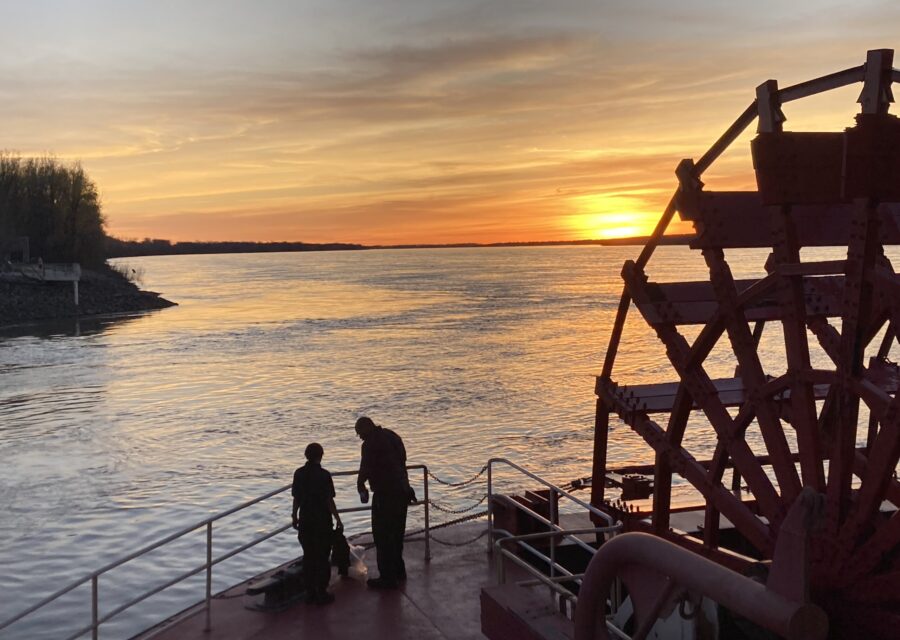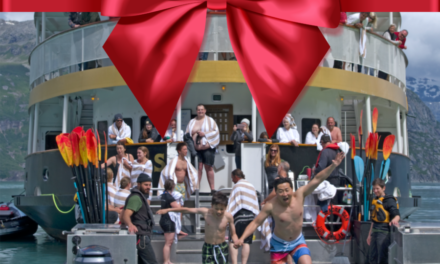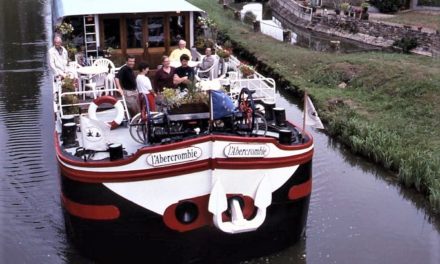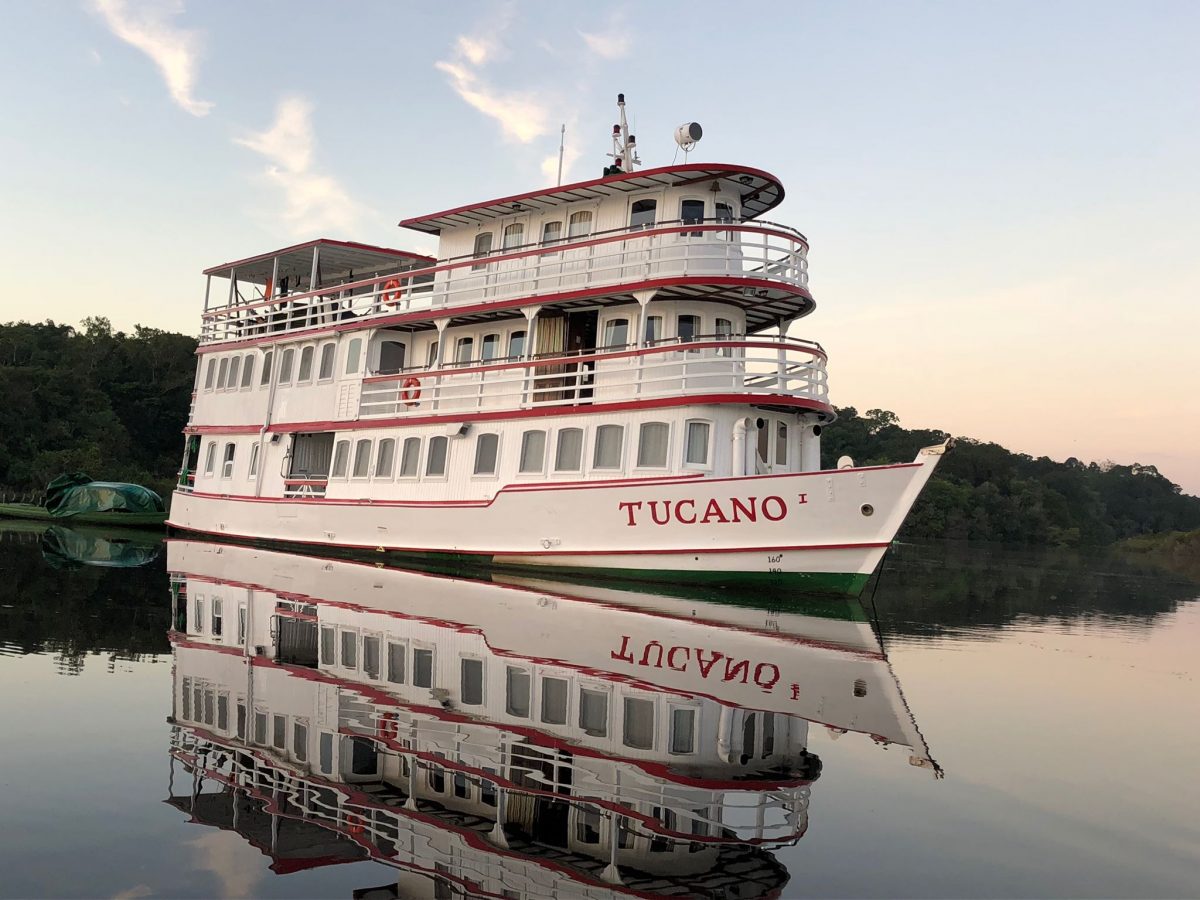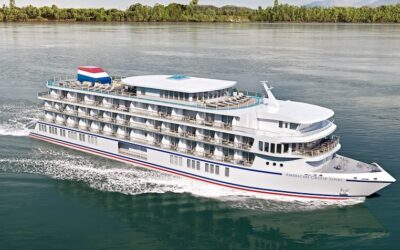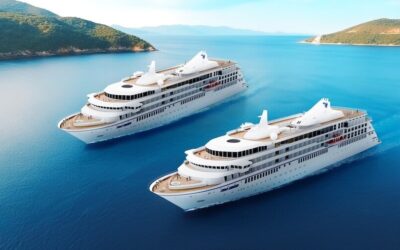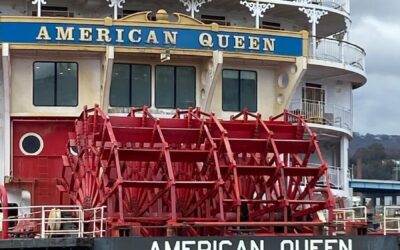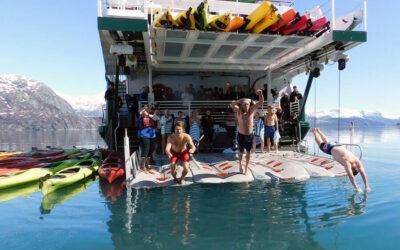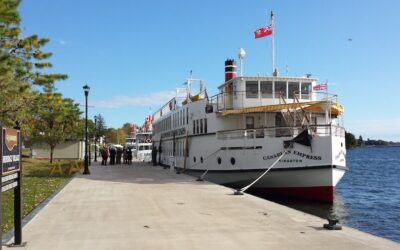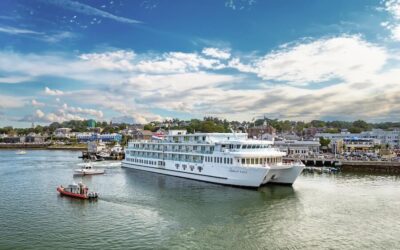American Queen Review
By Karl Zimmermann
Update Feb 24, 2024: The three riverboats of American Queen Voyages, including the American Queen, ceased operations earlier this week as will the company’s pair of coastal ships. The bottom line is that the line never recovered from the COVID period, and the American Queen was the only member of the fleet that turned a profit.
The American Queen is indisputably the matriarch of the Mississippi, and the monarch too — the largest steamboat ever to ply what were once known as the “Western Rivers,” the Mississippi and its many tributaries.
Launched in 1995, she is the sole overnight ”true” steamboat on those waters, now that her one-time fleetmates have been scrapped (the 1976-built Mississippi Queen) or idled but intact (the lovely Delta Queen, launched in 1927 along with consort Delta King for packet service on the Sacramento River Delta and essential to the American Queen’s origin story).
My wife Laurel and I boarded the American Queen in New Orleans on February 27 (2023) for a seven-night, 640-mile paddle up the Mississippi to Memphis.
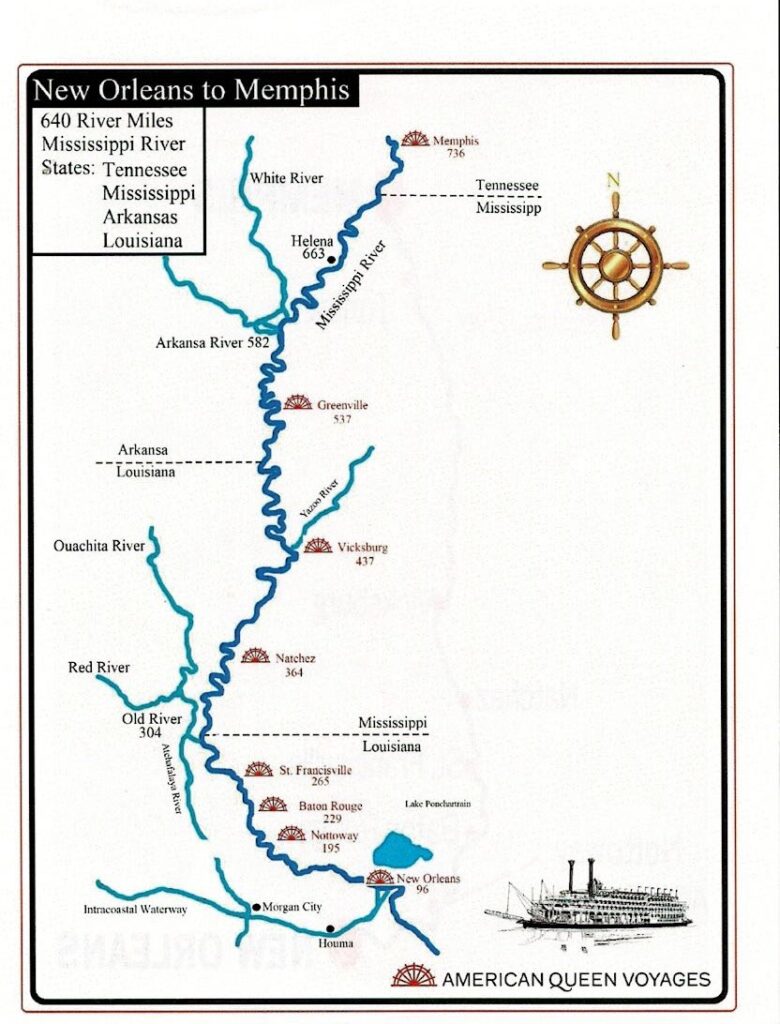
This would be our squiggly journey north, against the current and therefore slower and thus disallowing the Baton Rouge call that the southbound itinerary includes. * Map: American Queen Voyages
It wasn’t our first time aboard this elegant, substantial, and traditional vessel — that had come nearly 28 years earlier, and it was quite an adventure.
That story will come later.
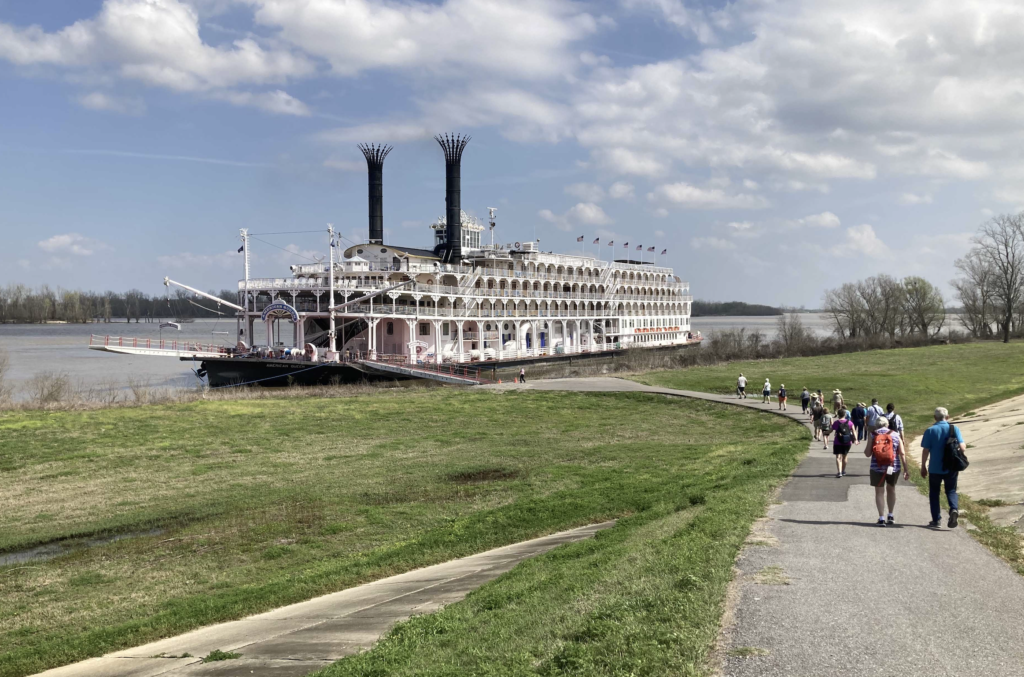
At Nottoway, Louisiana, our first port of call, these passengers eschewed the two golf carts the American Queen carried to provide lifts for those who wanted them and ambled down the levy back to the ship on a beautiful late-February afternoon. * Photo: Karl Zimmerann
Subscribe to our monthly small ship cruise email
Subscribe to QuirkyCruise.com for monthly curated newsletters highlighting our top small cruise ship reviews, round-ups & offers!
American Queen Review — New Orleans is Old But Never Grows Stale
Standard procedure for American Queen Voyages is to include a pre-cruise hotel overnight in the voyage package, and ours was at the Hilton New Orleans Riverside, ideally located right on the Riverwalk and just a few steps from where the American Queen docked.
Though we didn’t add time, we made good use of the evening of our arrival and the morning and afternoon of sailing day, revisiting places we’d enjoyed on previous trips; as is appropriate for New Orleans, we focused on meals.
For dinner we chose Tujagues, founded in 1856. It had recently moved a few blocks from its long-standing location across from the French Market but had taken its bar, its menu, its charm, and its enticing neon sign with it.
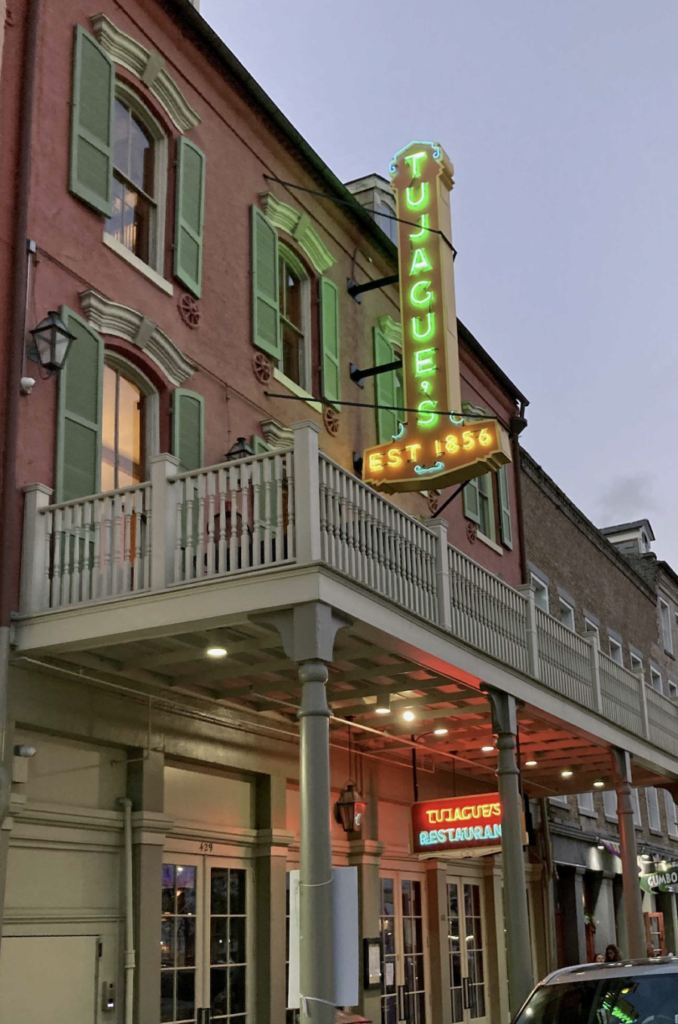
In the French Quarter of New Orleans, the traditional neon sign of Tujague’s, a long-time favorite restaurant of ours, was a beacon to help us find the establishment’s new location, just blocks away from where we first knew it. * Photo: Karl Zimmermann
After Sazeracs, the rye and absinthe-based cocktail created in New Orleans about the time Tujagues opened, we shared and mixed and matched starters for a meal: Oysters Bienville (cornmeal fried on a bed of Bienville filling with a drizzle of truffle oil), zesty Shrimp Remoulade, and the highlight, Escargot Orleans (tender escargot, leeks, oyster mushrooms and fennel in roasted-garlic butter).

Tujague’s is classic New Orleans: white tablecloths, delicious baguettes in monogramed sleeves, Sazerac cocktails. * Photo: Karl Zimmerann
In the morning, since the included buffet breakfast at the hotel was attractive, we skipped the long walk to (and long lines at) the Café du Monde for strong coffee with chicory and beignets. I was hoping to get an early taste of the week ahead by trekking down the Riverwalk to watch the Natchez (a genuine steam-powered sternwheel day boat, built in 1975 using a salvaged 1925 steam plant) sail amid calliope playing and whistling.
Sadly, I learned that the boat had been damaged in Hurricane Ida, was in dry dock, and that City of New Orleans was standing in. I wasn’t fooled by the red paddlewheel, seemingly de rigueur for excursion boats all over the country; it was diesel powered, like all the other would-be steamboats except the Natchez and Belle of Louisville.
Lunch at another old favorite, Acme Oyster House, in the French Quarter as is Tujagues, cheered me up. (Again, follow the neon.)
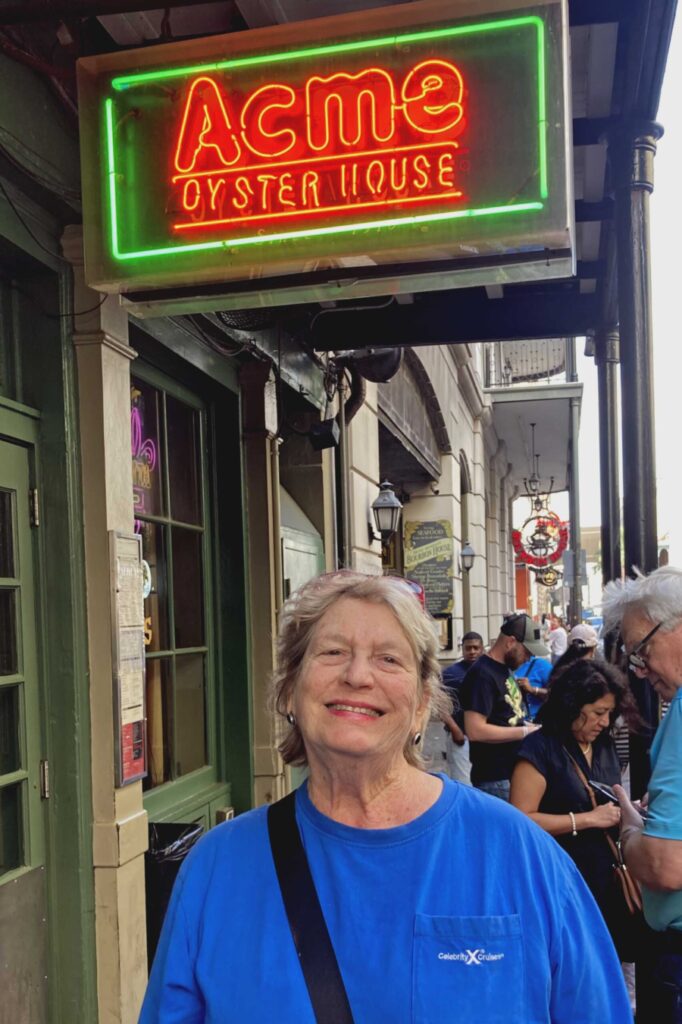
Laurel stands under the sign of Acme Oyster House, another of our French Quarter favorites, where we went for lunch on the day of sailing. This informal establishment’s specialty is obvious. * Photo: Karl Zimmermann

In the past we’d enjoyed sitting at the bar and watching the expert shuckers do their work, No seats for us there this visit, but we entered with virtually no wait, which was unusual. * Photo: Karl Zimmermann
Though there are plenty of other options, Acme’s specialty obviously is oysters: raw on the half shell, fried, and chargrilled. We skipped the last option but had plenty of the other two.
To get there we hopped a red Canal Street streetcar, an air-conditioned replica of the dark-green century-old Perley Thomas cars (air-conditioning by open windows) that ply the St. Charles Avenue line through the city’s Garden District.
Day transit pass for seniors is 80 cents but we didn’t expect change back when we put our dollars in the machine. If you’re not a senior a “Jazzy Pass” will cost you $3 for a day’s worth of travel.

New Orleans is famous for its streetcars, including the long-defunct one named Desire (for Desire Street, which really did exist and wasn’t a figment of Tennessee Williams’s imagination). We lacked time this visit to ride my favorite, the historic St. Charles Avenue line, but did use a Canal Street car to get to Acme, then returned on one that continued onto the Waterfront Line. * Photo: Karl Zimmermann
Exploring Our Boat, the First Part of My American Queen Review
Soon, however, the American Queen’s deep-throated steamboat whistle would send us on our way upriver, Memphis-bound, at 5 o’clock.
VIDEO: Below, the American Queen’s beautifully melancholic whistle.
A bit after 3 p.m. we were taken to the boat, docked less than a hundred yards from the Riverside Wing of the hotel, via motor coach by boarding group. A fleet of five of these spiffy vehicles — broad-windowed, skylighted, with relatively low seat backs for good visibility — would shadow us the entire voyage, operating the tours.
We found our room — number 405, forward on Observation Deck, auspiciously named “Mississippi River” — and were delighted with the location.
(The rooms on Observation and Promenade Decks are named for the Mississippi’s many tributaries, but ours was the mother river.)
When we walked around our deck for exercise, six circuits to the mile, it was fun to read the evocative and euphonious river names when we glanced inward from the ever-changing Mississippi views.
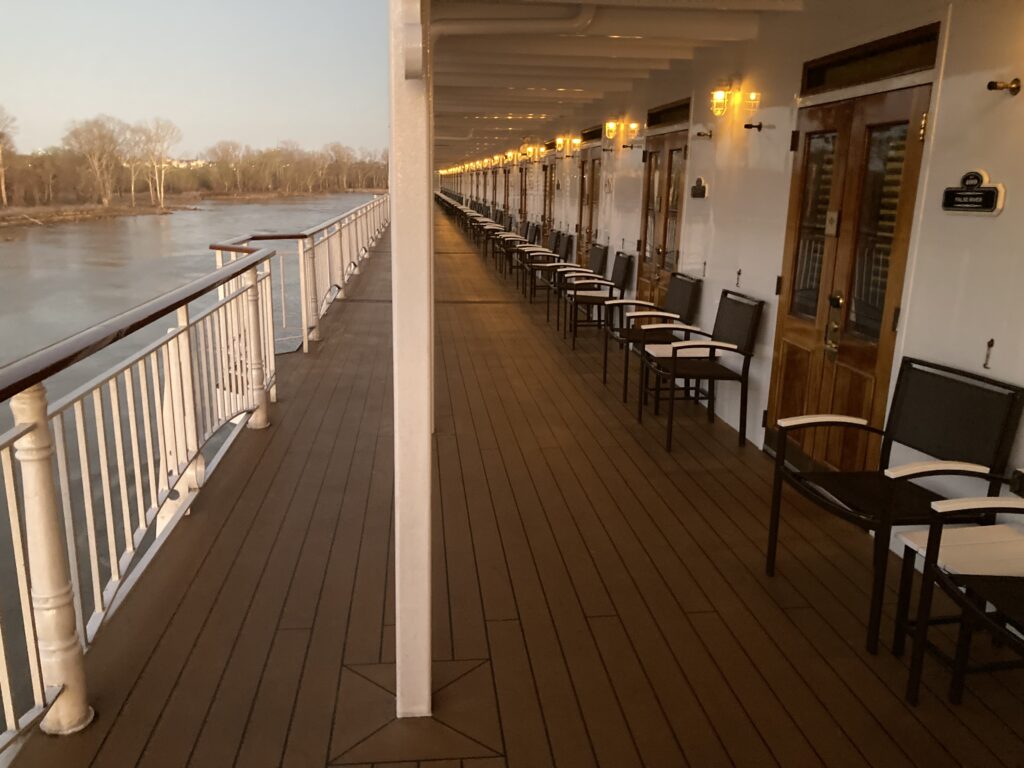
Beautiful though the American Queen’s interiors are, we did love to be on deck, and in classic steamboat style our cabin opened right onto this one, Observation Deck. * Photo: Karl Zimmermann
In classic steamboat style, our room’s double doors opened right onto the deck.
(The boat does have a few dozen premium rooms with private verandas, but we preferred our arrangement, partly for sociability. We became good buddies with our neighbors in “Atafalaya River,” Paula and Benny from California.)

We thought our cabin both comfortable and attractive. The passage to the right of the bed led to a closet area and the bathroom. An antique-style combination bureau-secretary desk stood next to the louvered doors to the deck. * Photo: Karl Zimmermann
Just steps away was the Chart Room, a woody library that also held charts and other navigation information. A screen there and in the cabins always showed a chart of the boat’s current location.

Just steps from our cabin was the Chart Room, looking cozy at night, warmly lit including its cupola. Seen through the window is the boat’s only wheel, as the “wheelhouse,” or “pilot house,” has none. Below the windows are bronze plaques listing the passengers from the boat’s inaugural season. * Photo: Karl Zimmermann
“Riverlorian” Lee, a Bonafide Pilot
We could often find Lee Hendrix, the “Riverlorian,” in the Chart Room. The term and concept of “Riverlorian” (a portmanteau word connoting historian and purveyor of the lore of the rivers) predates the American Queen, apparently being coined aboard the Mississippi Queen.
Lee has had a long career as a riverboat pilot and still sometimes fills that role, so his knowledge of the river is encyclopedic. His daily talks became part of our onboard routine. It was he who led me on a tour of the wheelhouse the first morning.
“I’m not good-looking, I’m not rich, but I’m accessible” he said early on, and that proved to be true.
Forward on our deck, in front of the Chart Room, was a welcoming row of rocking chairs, and right down the deck staircase was the Front Porch Café, an informal alternate spot for all meals, buffet style. There was a large, covered outdoor deck with a variety of seating, and an indoor space should it be too nippy outside.

The Front Porch, just down a staircase from our cabin, was our choice for breakfast most days and often lunch if the weather was temperate, which it mostly was. * Photo: Karl Zimmermann
Breakfast was similar every day and I kept coming back: eggs and omelets cooked to order, fluffy, buttery biscuits with sausage gravy, bacon, sausage, potatoes, alternating specialties, such as a burrito, along with fruit, yogurt, and pastries.

The buffet line in the Front Porch Café, serving food brought from the main kitchen below, is to the rear in this picture. We found ample tables for the few chilly days, but if the boat were full that might be a problem. * Photo: Karl Zimmermann
Our mornings routinely began with my bringing cappuccino from the machine there to the chairs on deck right by our cabin door. In addition to the three squares, a hot-dog stand appeared on the porch afternoons, buns and dogs and all the trimmings.

The Front Porch Café also held the all-important popcorn machine, popcorn being a must-have for Laurel, smiling here. She and Ted Scull first indulged their mutual addiction to popcorn on the Mississippi Queen in March 1996. * Photo: Karl Zimmermann
American Queen Review — Paddling Off as the Calliope Played
We’d hastily unpacked, briefly renewed our acquaintance with the vessel — over the week we’ll explore every nook and cranny — but knew exactly where to be for our five-o’clock sailing: aft on Promenade Deck, where we could watch the paddlewheel come to life and hear Phil Westbrook’s sendoff on the steam calliope, with its 37 gold-plated brass pipes.
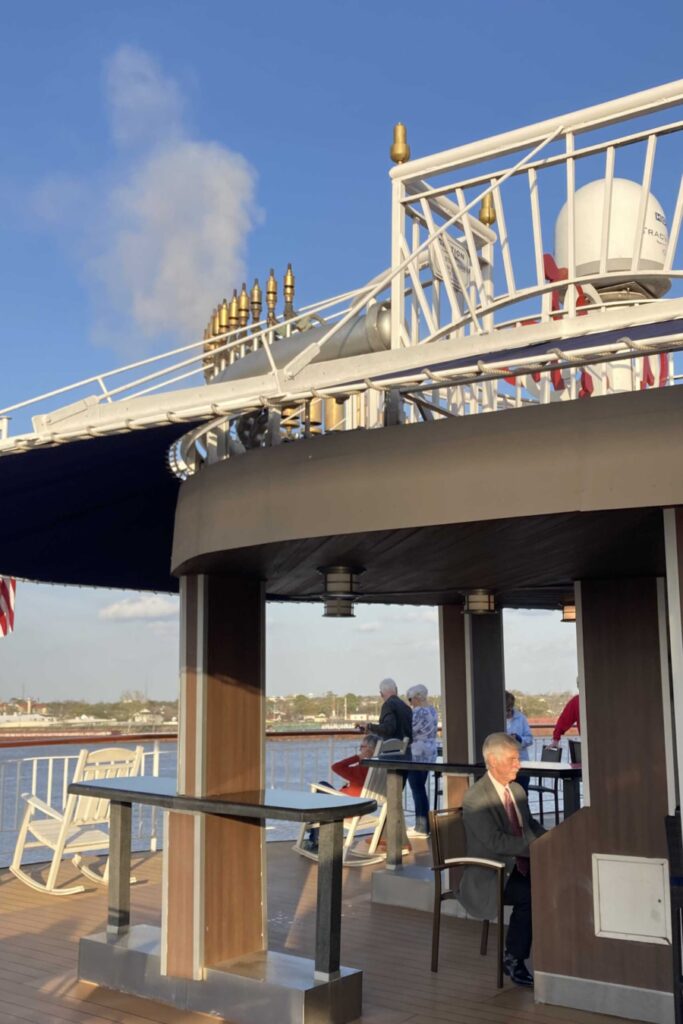
Calliope concerts punctuated each sailing, and Phil Westbrook does the honors here as we leave New Orleans for our 640-mile adventure. * Photo: Laurel Zimmermann
This we quickly realized would be our happy spot every early evening. If it was a port departure Phil or Jay Chalmers, another pianist, would herald it on the calliope, playing traditional ditties redolent of river and patriotism.
Historically calliopes are very much a steamboat thing, a must-have, and of course steam to play them is readily available.
VIDEO: Below, a little taste of what the calliope sounds like.
They’re loud, meant to be heard ashore as well as on board, and some of the close-at-hand audience on Promenade Deck did cover their ears. Showboats used calliopes as advertising, notifying potential audiences that the show had come to town.
Later in the cruise passengers would be given the chance to play, and executing even a single note would qualify for a “Vox Calliopus” certificate.
But calliope or not we’d be there to sip a Manhattan or old fashioned obtained from the oddly named River Grill and Bar there (no food) and be mesmerized by that magical red paddlewheel and watch the river glow in sequential sunsets (we were very lucky with the weather).

The churn and splash of the paddle wheel was our evening symphony, whether as background to the calliope — the instrument was named for the Greek muse of poetry and song— or on its own. * Photo: Karl Zimmermann

We’d generally linger on deck before dinner to watch the sunset, seen here from right outside our cabin door. This one we shared with Taylor, who took care of our cabin and valued her time on the rivers. “I love it in the evening when the fog rolls in,” she said, “and the stars on a dark night when we’re away from cities.” * Photo: Karl Zimmermann
VIDEO: Below, the calliope plays as the red wheel turns.
American Queen Review — New Orleans, Port City
That first evening we marched up the river, paddlewheel churning, past maritime New Orleans, wharf after wharf: First Street, Harmony Street, Seventh Street, Nashville Avenue, Henry Clay Avenue Wharves — most wooden, redolent of a break-bulk era, when cargo was unloaded and reloaded, before ubiquitous containerization.
Any deck was our favorite place to be, and often serendipitous things occurred there.
It was dark that first night by the time we stepped out on deck from our cabin, headed to the dining room, and there on the eastern shore was the handsome Natchez that I’d hoped to see under steam in New Orleans, now floodlighted in dry dock.

Amazing serendipity: As we stepped from our cabin on the first evening, headed for dinner, there was my second favorite sternwheel steamer Natchez, in dry dock. Its presence there encouraged me to think that it would steam again. * Photo: Karl Zimmermann
With dinner, here again we were lucky as we would be with the weather. Normally the boat offers two-sittings and we’d been assigned the “main,” at 7:45, late for us. However, the “Daily Voyage” information sheet listed “open dinner seating 5:15-7:30,” which suited us just fine.
We thought it was only for the first night, but it continued through the voyage.
I later learned, the boat was roughly half full, 215 passengers of the 415 maximum.
Over 225 required two sittings, so we barely skinned through.
American Queen Review — The J.M. White Dining Room, Pluses & Minuses
The grand and elegant J. M. White Dining Room gets its name from the 1878 steamboat J. M. White, the primary inspiration for the retro American Queen’s design, though it was a side-wheeler rather than a sternwheeler.

The soaring, two-deck high side sections of J. M. White Dining Room are a splendid recreation of Victorian elegance. When full for dinner, however, it was auditorily challenging. * Photo: Karl Zimmermann
Of course it had plenty of open space on Main Deck to carry bales of cotton, its main revenue source. But the arcaded passenger decks above suggest the look of the American Queen, the AQ’s ornate pilot house is a virtual copy, and the tall fluted stacks, designed to keep smoke and sparks away from the passengers and cotton (the boats were mostly wood-fired in those days), were also borrowed. (Some etymologies of the term “highfalutin” cite such oversized fluted stacks as the source — a stretch, perhaps, but the word was a mid-19th-century American coinage so that would work.)
We were enjoying the early evening on deck and the froth of the paddlewheel so much that we were slow in getting to dinner, and table choices were slim. We were offered a spot for two in an adjacent, small, subsidiary dining room, only used for single-sitting dining, and that became our table of choice, because here’s the thing: the J. M. White Dining Room is majestic and impressive in its Victorian detailing and spacious feel but very loud, at least to my ears.
The center section has a low ceiling, but the two sides soar up a second deck, overlooked by windows in the Mark Twain Gallery. The second night we joined a table for eight and conversation was difficult. A compounding factor is the noisy generator lurking below deck on the starboard side.

Windows in the Mark Twain Gallery on Cabin Deck allowed nice views down into the J. M. White Dining Room. * Photo: Karl Zimmermann
Our first dinner in the small room, where we found the servers exemplary, was creative: coffee-rubbed filet for me and deep fried coconut lobster tail for Laurel. Shrimp remoulade on fried green tomatoes was a scrumptious starter. A few days later lobster tails would return, delicious, served on with creamed spinach and removed from the shell at table by Isaac.
We did find the dinner quality up and down, a highlight being succulent lamb chops.

Isaac, one of the excellent and personable servers in the small annex to the dining room that we preferred, removes a lobster tail from its shell for Laurel. * Photo: Karl Zimmermann
American Queen Review — The Tours
American Queen Voyages typically offers included tours at every port, plus at least one and usually two “Premium Experiences,” longer and more involved, for a fee.
We had learned from sailing the previous summer across the Great Lakes aboard the line’s Ocean Voyager that the included tours were just splendid, and that’s the route we took on the American Queen. Most were hop-on, hop-off with our captive buses and excellent local guides, and departures continued throughout the port calls, a flexibility that we liked.
However, Nottoway, the first port, was different. As I walked forward on our deck as we arrived, the lines were just being secured and the portside landing stage lowered into place. The boat’s two landing stages were emblematic of Mississippi River steamboats, allowing them to land anywhere, and tie off to whatever was handy.
The folksy term for this, “choking a stump,” described lines wrapped around a tree or stump, secured by a clamp called a “deadman.”

This is how to “choke a stump,” to tie up most anywhere along the rivers. The clamps securing the lines are called “deadmen,” one of the many bits of fascinating arcana I learned from Riverlorian Lee. * Photo: Karl Zimmermann
The object of today’s visit, heavily columned Nottoway Mansion, built in 1855 by John Hampton Randolph combining the Greek Revival and Italianate styles, had just emerged from the morning fog, a white, ghostly castle.
American Queen Review — First, the Pilothouse
Before disembarking at Nottoway, I took that pilothouse tour with Riverlorian Lee, where I was reminded that the tall, fluted stacks folded down to clear low bridges, and the wheelhouse could be hydraulically lowered into the Sun Deck and radar mast folded down.

In the pilot house, Hendrix, long a licensed pilot, explained aspects of the boat’s operations. Visible to the left are the controls that lower and raise the stacks, necessary when navigating under low bridges. The ornamental crown of the pilothouse can be removed as well, and radar masts folded. * Photo: Karl Zimmermann

The up and down dance of the stacks always attracted attention, including mine. It was a noisy process, and the starboard stack (actually a dummy, for show only) was right above our cabin. In the middle of a breezy night, pajama clad, I went on deck to watch, only to have the cabin door slam shut and lock. A good deal of pounding finally woke Laurel to let me in. * Photo: Karl Zimmermann
Lee also revealed a fact that may have surprised some. While the steam engine that drives the paddlewheel is 100 percent real, constructed in 1932 for the dredge Kentucky, diesel-electric “Z-drives” provide about half the power.
This didn’t diminish my pleasure in frequently visiting the engine room, the beating heart of the vessel, open to passengers at any time.
VIDEO: Karl has a look around the engine room, below.
It’s accessed through the Engine Room Bar, itself well worth a stopover.
There through rear-facing portholes patrons can watch the paddlewheel churn, floodlit at night.
VIDEO: Below, the view of the churning paddlewheel through the windows.
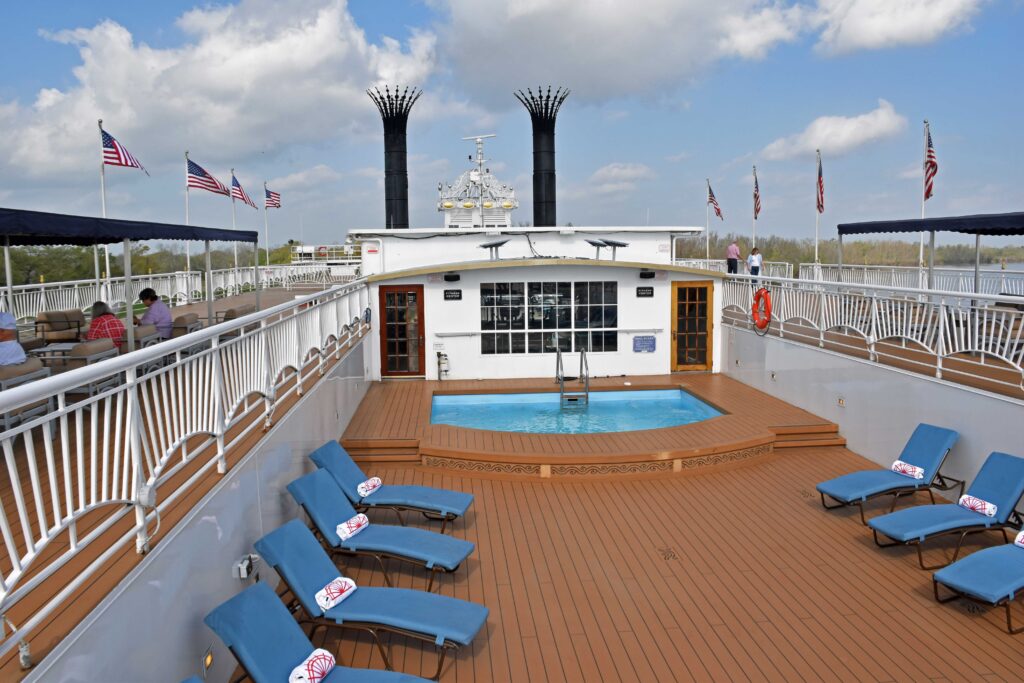
Aft on Sun Deck were some perhaps unexpected cruise-ship-type amenities: a small pool, lounge chairs, and, behind the windows, a small fitness center. The pilot house is wearing its tiara as no bridge is imminent. * Photo: Karl Zimmermann
American Queen Review — Touring Nottoway
After lunch I took the Nottoway mansion tour led by Nikki — a Texan who went to LSU, never left the state, and was married at Nottoway.
But she proved more than photogenic, offering a tour that was superb and polished, full of interesting tidbits, and — as is de rigueur these days — forthcoming about the role of slavery in the mansion’s past.

Nikki, standing here in the dining room of Nottoway, which claims to be the finest surviving antebellum mansion in the South, was an exceptional docent, knowledgeable and well-spoken. “Y’all are welcome to take pictures,” she said by way of introduction, “and they’ll be better if I’m in them.” No argument there. The house had many stories to tell, and she articulated them perfectly. * Photo: Karl Zimmermann
The American Queen Itself Has History
To fully appreciate the American Queen means to know its history, nicely presented in “Dare to Dream,” a 30-minute documentary about the boat’s building and inauguration, shown in the Grand Saloon, the performance space.
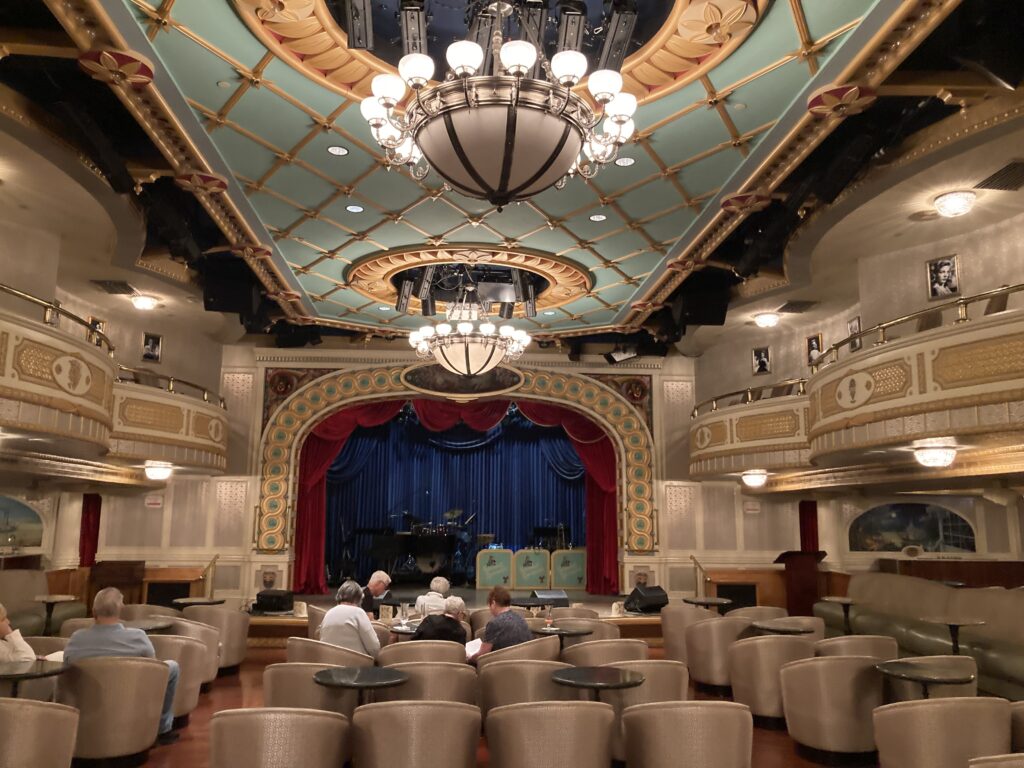
The American Queen’s Grand Saloon, home for Lee’s daily talks, the nightly shows, and more, is a stylish evocation of a Victorian-era small-town opera house, with some details modeled on Washington’s Ford’s Theater. It also recalls the showboats that once brought entertainment to the river towns. * Photo: Karl Zimmermann
The legacy goes back to the Delta Queen; like its twin, the Delta King (now a hotel in Sacramento, the boats’ original destination from San Francisco), it was built too late for the packet service it originally filled, hauling mail, freight, automobiles, and passengers, and soon was made obsolete by a new highway.
Idled for a time, Delta Queen was bought in 1946 by Greene Line Steamers of Cincinnati, towed through the Panama Canal, and launched on its new career on the Mississippi River and tributaries two years later.
Imperiled in 1966 by a Safety at Life at Sea law prohibiting wooden superstructures on ships enacted after a devastating fire aboard an ocean-going ship, the Delta Queen for years received a series of Congressional exemptions because a riverboat could “chock a stump” within minutes and unload passengers.
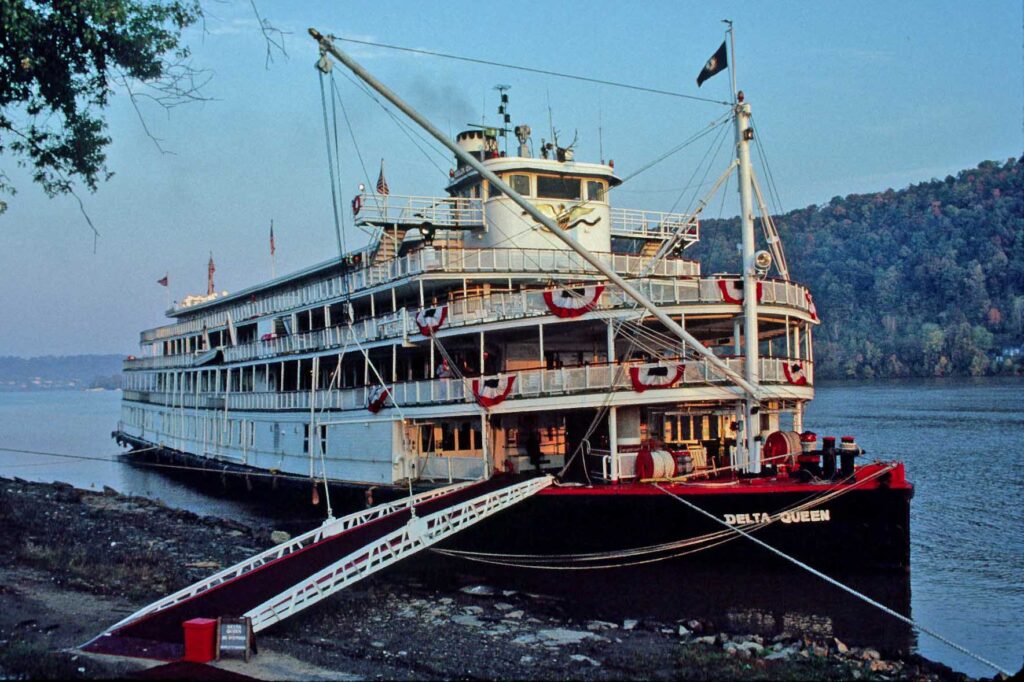
The Delta Queen, seen here in Maysville, Ohio, on October 17, 1990, was built in 1926 for overnight service between San Francisco and Sacramento. It lent its name to the company that would build the American Queen. * Photo: Karl Zimmermann
For political reasons, the exemptions finally stopped in 2008. Earlier, amid this climate of uncertainty, the owner (now named the Delta Queen Steam Steamboat Company) hedged it bets and in the mid 1970s built the all-steel Mississippi Queen, with an authentic steam plant but larger and thus more profitable.
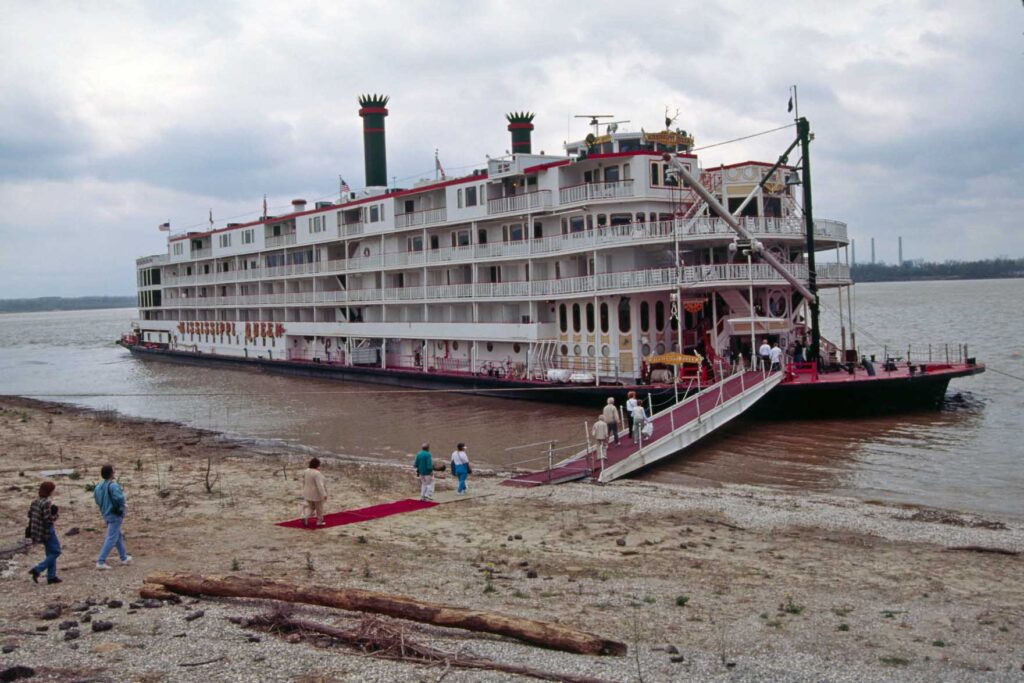
The all-steel Mississippi Queen, shown here boarding passengers in March of 1996, was built in 1976 as a hedge against the Delta Queen falling victim to the 1966 SOLAS law disallowing wooden superstructures. The MQ’s passenger capacity of 422 was well more than double the DQ’s (the AQ’s would be only slightly higher), a key to profitability. * Photo: Karl Zimmermann
But after a 9/11-induced layup it deteriorated and was subsequently scrapped.
The American Queen, designed to incorporate the elegance and historicity of the Delta Queen and practicality of the Mississippi Queen, was launched in 1995, with Victorian elegance throughout and a plethora of antique furnishings.
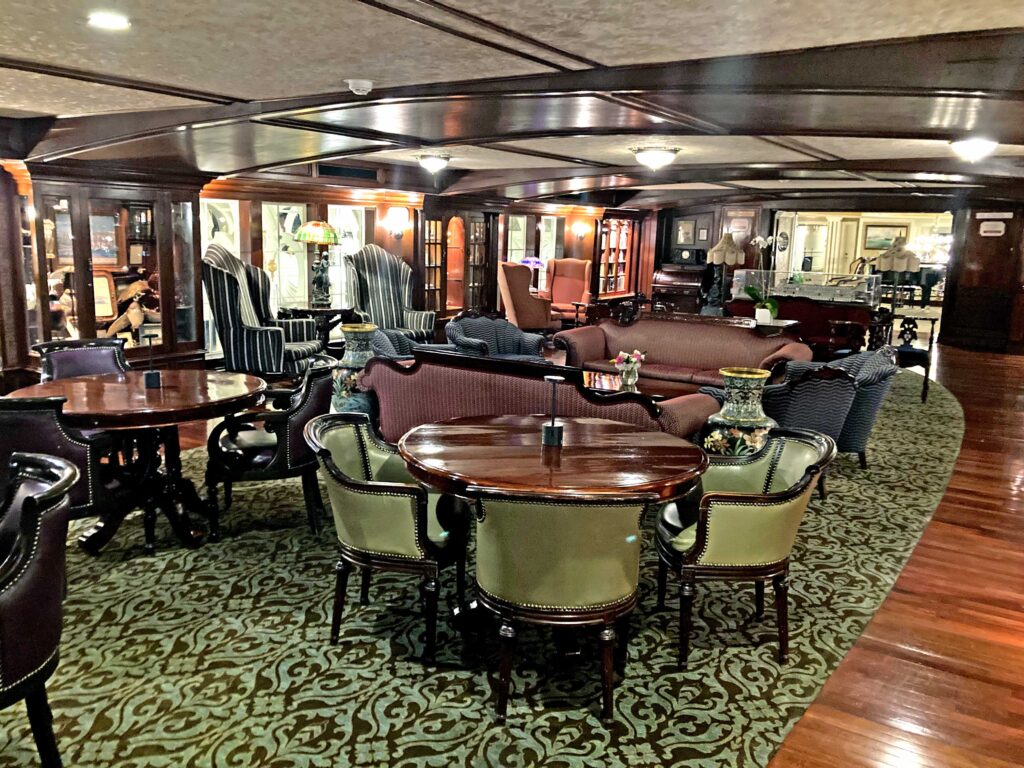
The Mark Twain Gallery, richly woody, is flanked with cases displaying steamboat and other period memorabilia. * Photo: Karl Zimmermann
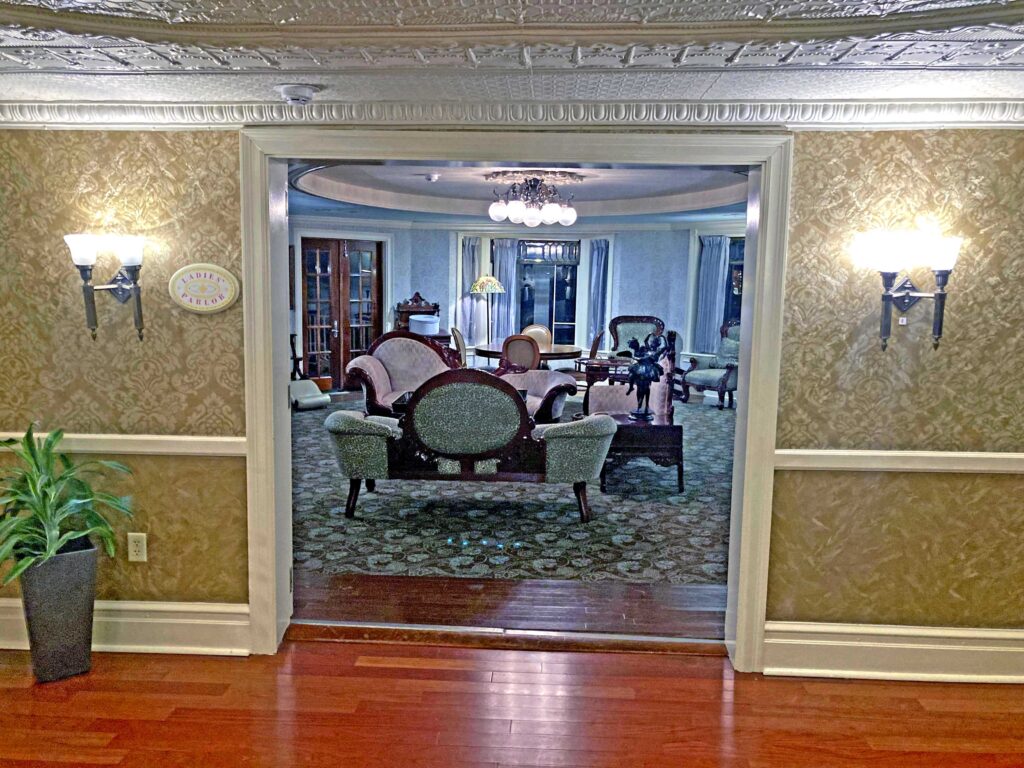
Located forward of the Mark Twain Gallery, the Ladies’ Parlor has a dainty Victorian elegance. * Photo: Karl Zimmermann

Across the hall from the Ladies’ Parlor is the Gentlemen’s Card Room. A taxidermist’s delight, it has a distinctly masculine vibe. * Photo: Karl Zimmermann
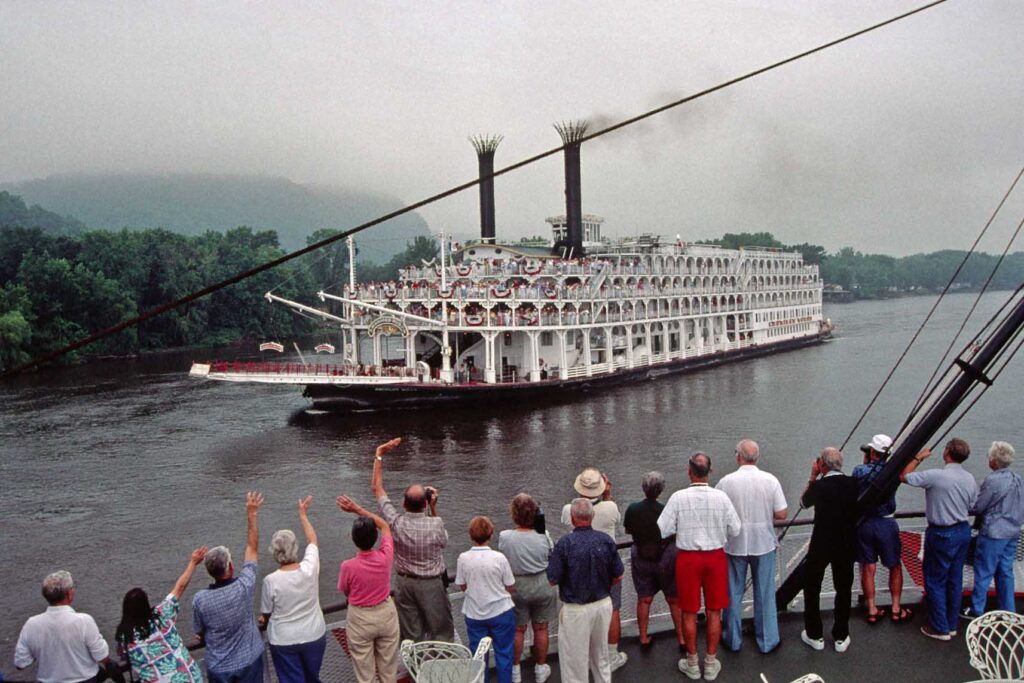
On the Upper Mississippi in July 1999, Delta Queen passengers wave to their counterparts on the American Queen. This was the heyday of the Delta Queen Steamboat Company, with three boats sailing. Note the AQ’s smokeless dummy starboard stack. * Photo: Karl Zimmermann
RELATED: Ted looks back at the debut of the American Queen.
RELATED: Ted interviews American Queen expert Bill Forsstrom about his many cruises.
We Choked a Stump
Laurel and I knew American Queen right from the beginning, since we were aboard a pre-inaugural run in 1995 destined from Memphis to Louisville for journalists and travel agents. Public relations had planned an aerial photo shoot midway through so, in order to be in just the right place for the morning sun, we pulled off and “choked a stump” overnight.
Problem was, unknown to the American Queen pilot, the Army Corps of Engineers, which managed the river and its locks and dams, dramatically dropped the water level.
On the morning of June 19, Laurel and I awoke to the roaring engines of an Ingram Marine towboat trying to pull us free. Its mates joined in over the next two days, but no dice.
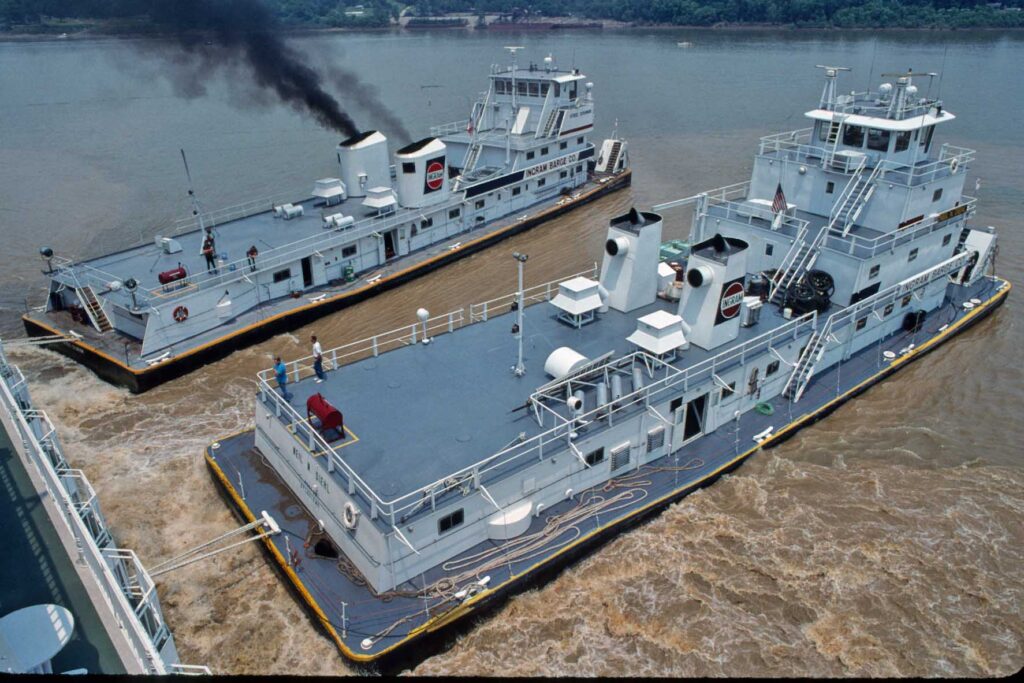
A pair of Ingram towboats strive mightily but futilely to pull the American Queen out of the Ohio River mud at Hawesville, Kentucky, on the boat’s pre-inaugural cruise to Louisville. * Photo: Karl Zimmermann
Eventually we passengers were barged off and bussed to Louisville. Various expediencies, including pumping off ballast and fuel, freed the boat and it began its inaugural trip on schedule.
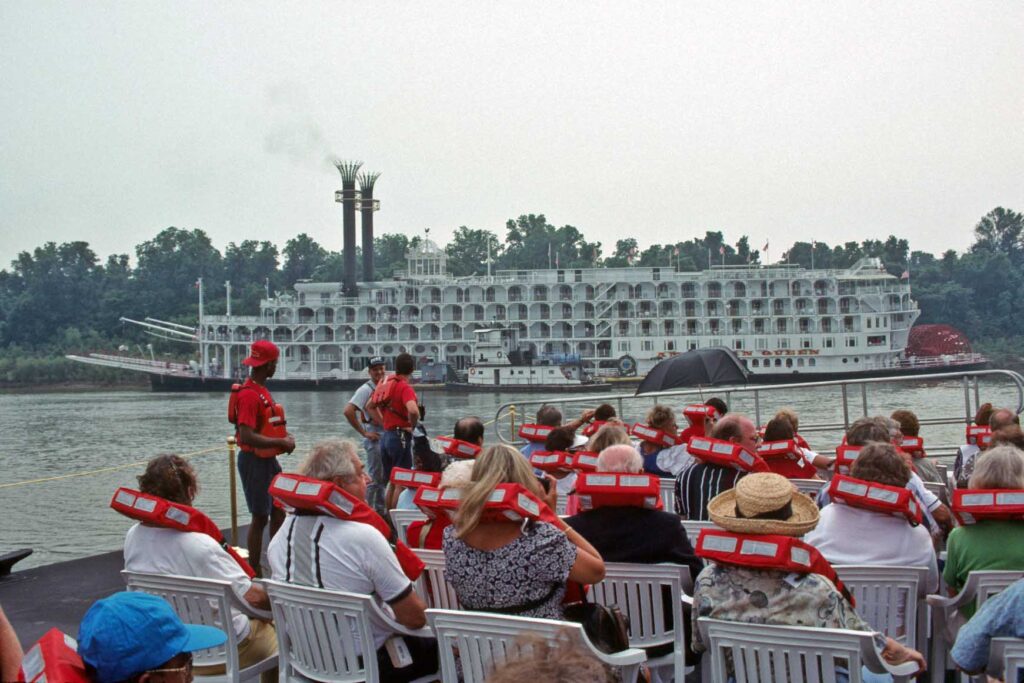
Eventually we gave up and hopped the offered barge ride from Hawesville across the Ohio to Troy, Indiana, and from there bused to our flight back to New Jersey. * Photo: Karl Zimmermann
(Not long after we arrived home, polo shirts with the logo “Choke-a-Stump Gang” appeared in the mail.)
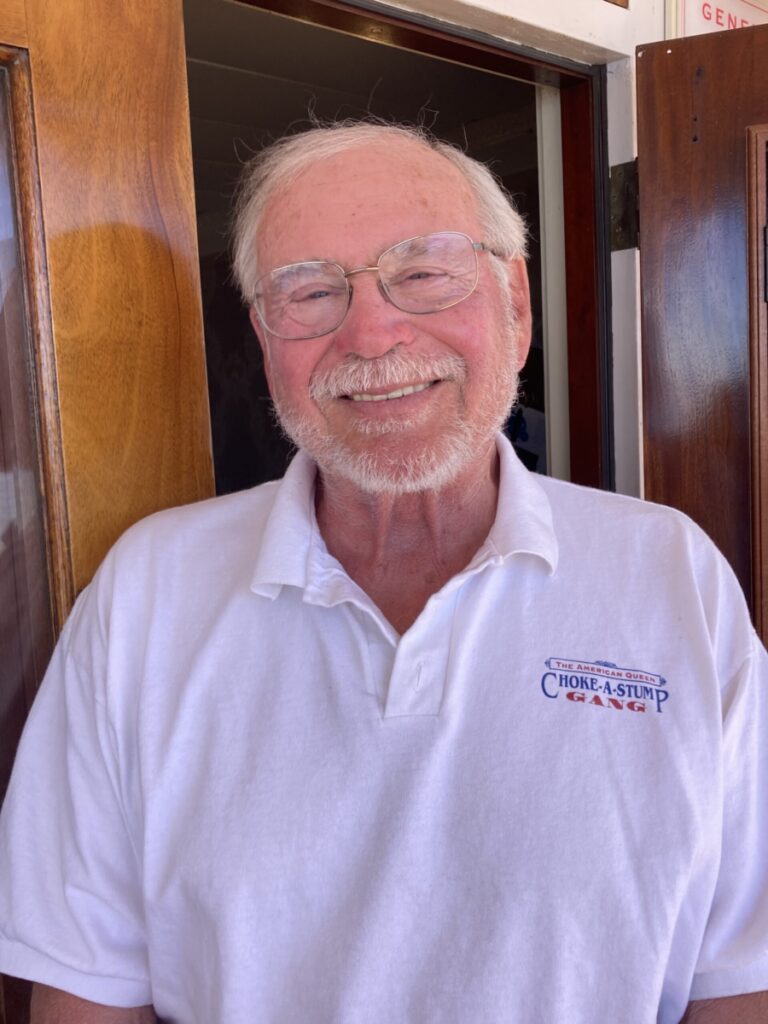
I still have the “Choke a Stump Gang” polo shirt sent by the Delta Queen Steamship PR director after the 1995 stumble and wore it proudly on our 2023 voyage. * Photo: Laurel Zimmermann
However, according to Lee, who served as pilot for much of its inaugural year, the boat’s teething problems weren’t over, as its paddlewheel was hors de combat (out of action) all that time, and the boat soldiered on successfully with just its Z-drives.
“We’re built for comfort, not for speed,” Lee had said, bringing us back to 2023, and we thought that summed it up.
Over and over in chatting with passengers, we heard “peaceful” and “relaxing.” We personally were happy with our slower, up-bound, itinerary, though I believe more prospective passengers preferred the faster, down-bound run, which allowed an extra port, Baton Rouge.
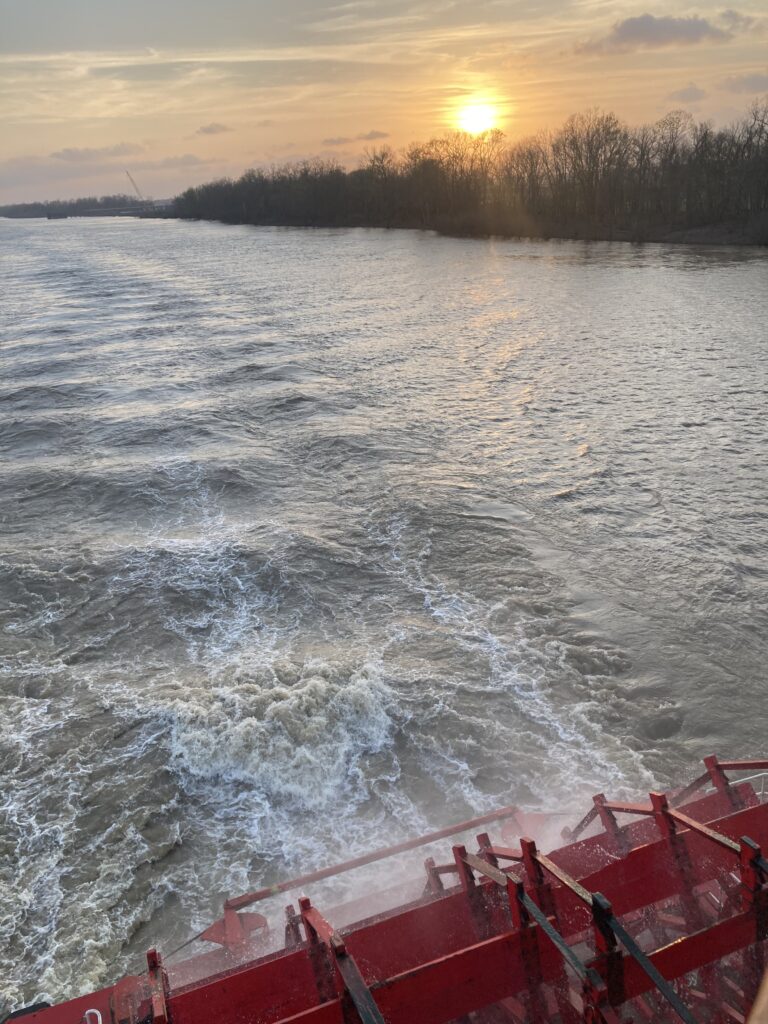
The aft table by the paddlewheel was nirvana for Zimmermanns, the perfect place to watch the sunsets. * Photo: Laurel Zimmermann
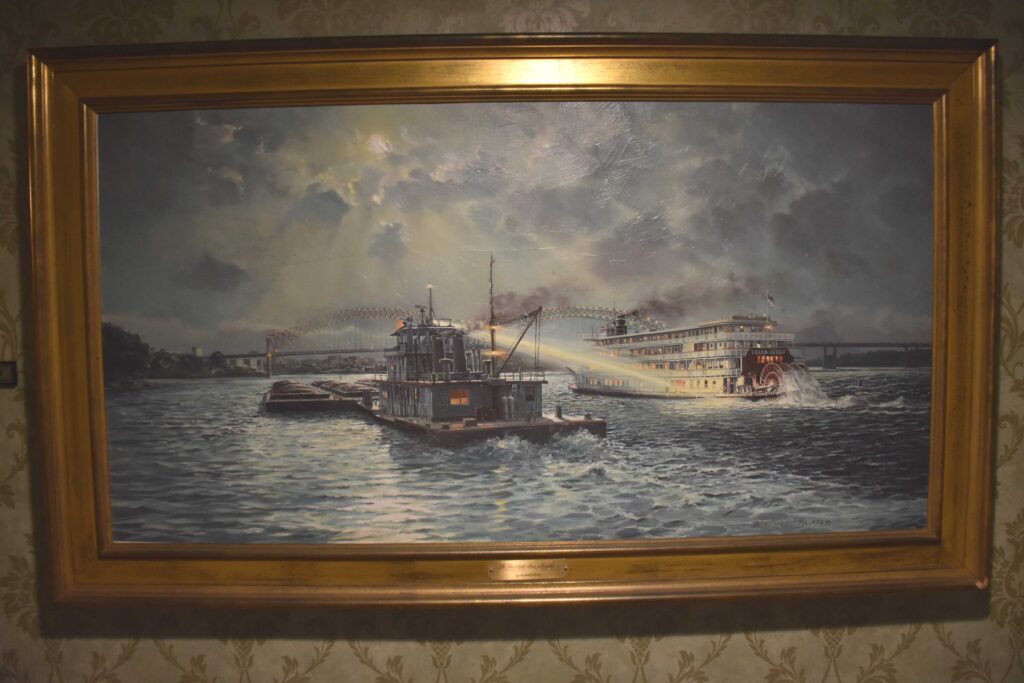
Throughout the public rooms and corridors are 60-plus oils by marine artist Michael Blaser, each evocative of commerce on the Western Rivers. This one, “The Moonlight Above Memphis,” shows a towboat’s searchlight picking up the Delta Queen’s paddlewheel. * Photo: Karl Zimmermann
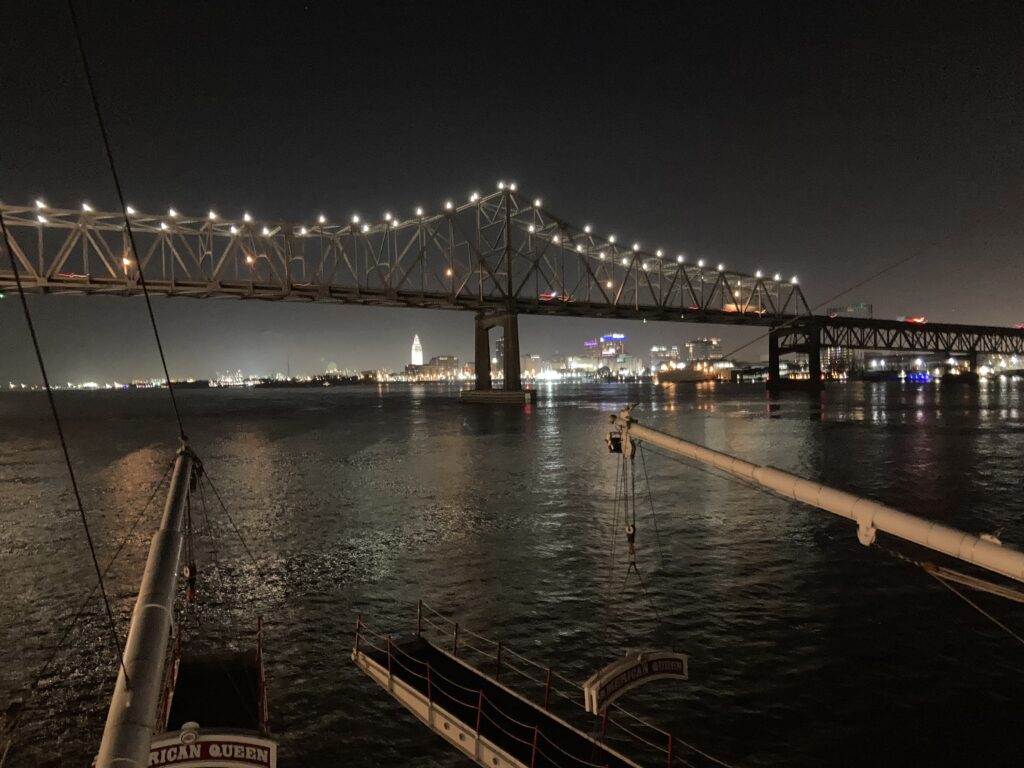
Passage by Baton Rouge came well after dark, but I thought the nighttime cityscape well worth waiting up for. * Photo: Karl Zimmermann
More Touring
The tours we made we liked a lot. The second stop, the town of New Roads in the parish of Pointe Coupée, was as unknown to us as had been Nottoway.
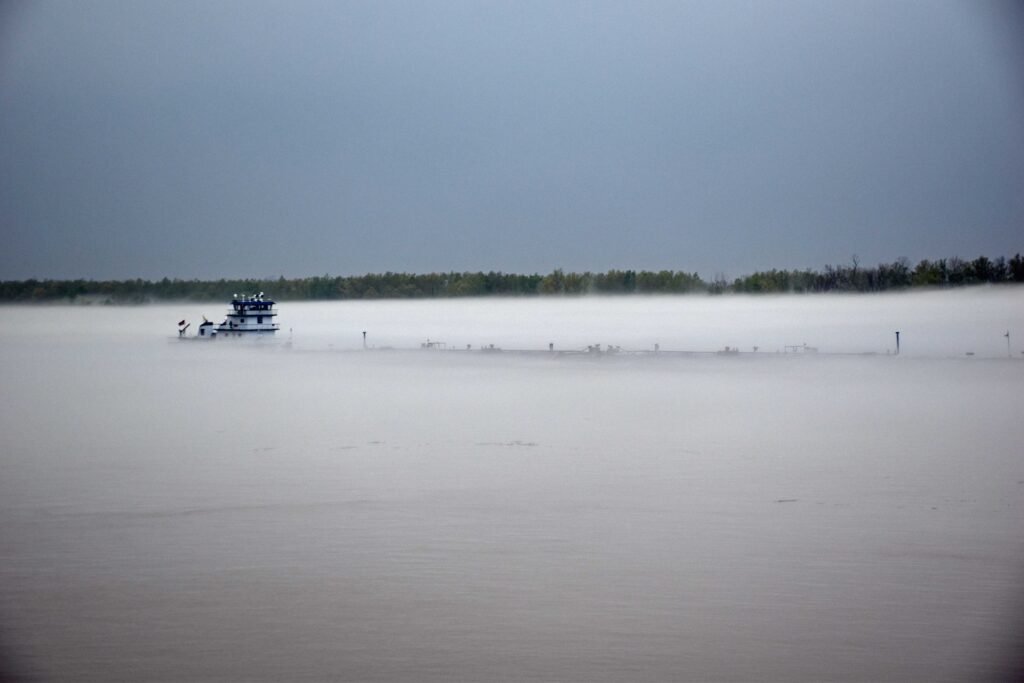
The river was shrouded in fog when we arrived at Pointe Coupée, Louisiana, our second port, and the barges of this southbound tow are barely visible. The short forward mast holds the “peep light,” which helps pilots steer in the dark. (Lee Hendrix’s memoir, Peep Light: Stories of a Mississippi River Boat Captain, will be published early next year by the University Press of Mississippi.) * Photo: Karl Zimmermann
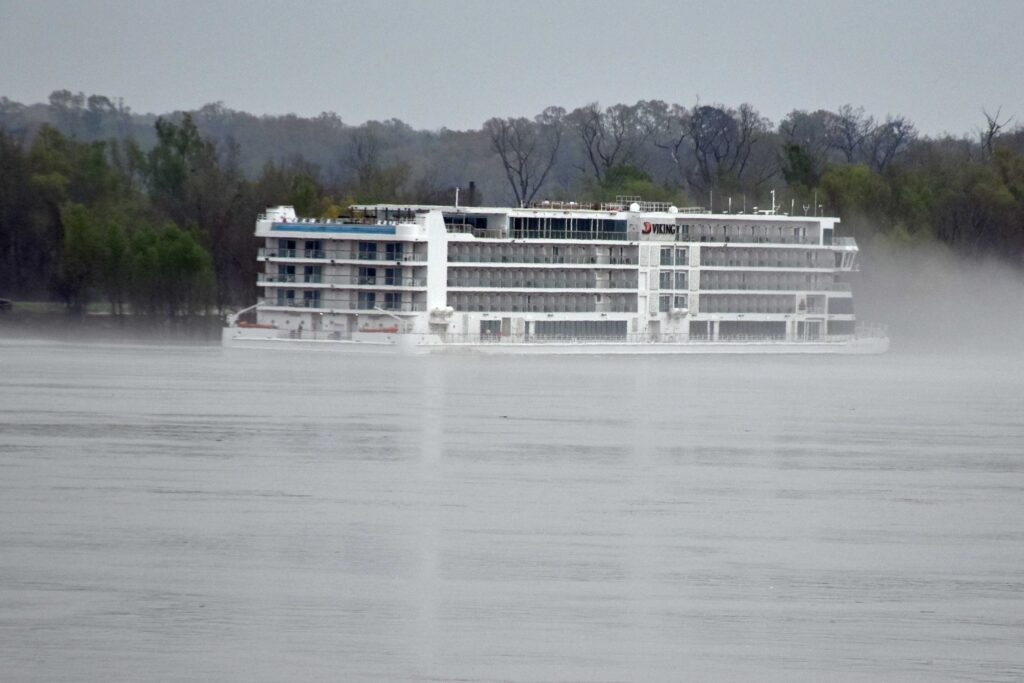
The American Queen’s competition, the Viking Mississippi, not a stump-choker, was docked across the river from Point Coupée at St. Francisville. Its look was wildly different from the traditional AQ’s, and I gazed at it without a twinge of envy. * Photo: Karl Zimmermann
It’s on False River, a trapped former oxbow of the Mississippi, now a sport boating and fishing mecca. (In contrast, on our entire voyage we did not see a single recreational boat on the Mississippi nor facilities to serve one. What we did see were many “tows” — the oxymoronically named compendium of barges, often a lot of them — pushed by a “towboat.”)
In New Roads we were welcomed to look around the privately owned Lejeune House.
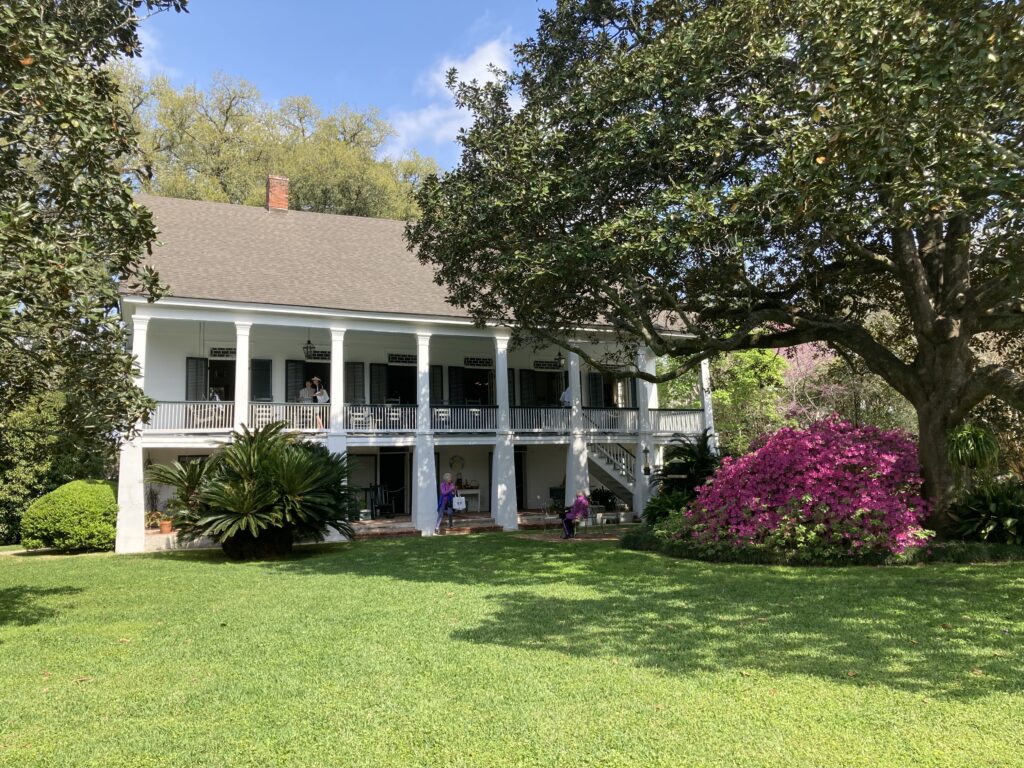
Our Pointe Coupée hop-offs were in New Roads, the Parish’s main town, The first was at LeJeune House, more than two hundred years old. * Photo: Karl Zimmermann
We then stopped at the visitor center, where the highlight for us was watching carver Henry Watson work and study his art, chiseled from reclaimed cypress wood from slave homes and barns and painted.
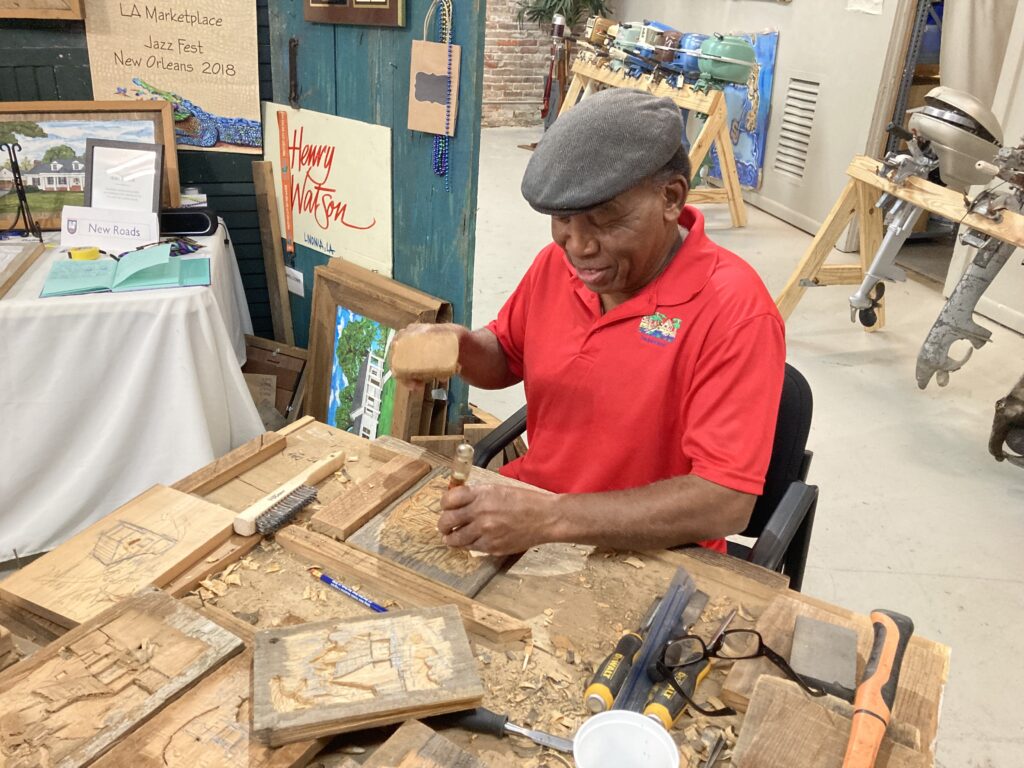
At the New Roads Visitors Center, we picked up some Mardi Gras beads with no obligations and browsed local artifacts on display, including an extensive collection of antique outboard motors. The highlight was seeing Henry Watson work and admiring some of his lovely creations. He first carves images from century-old cypress, salvaged from slave quarters and sharecroppers’ barns, then paints the carvings. * Photo: Karl Zimmermann
Next came Natchez. “Natchez under the hill,” where we landed, once the place for bars, brothels, and brawling, was sedate with a few tourist-friendly historic buildings.
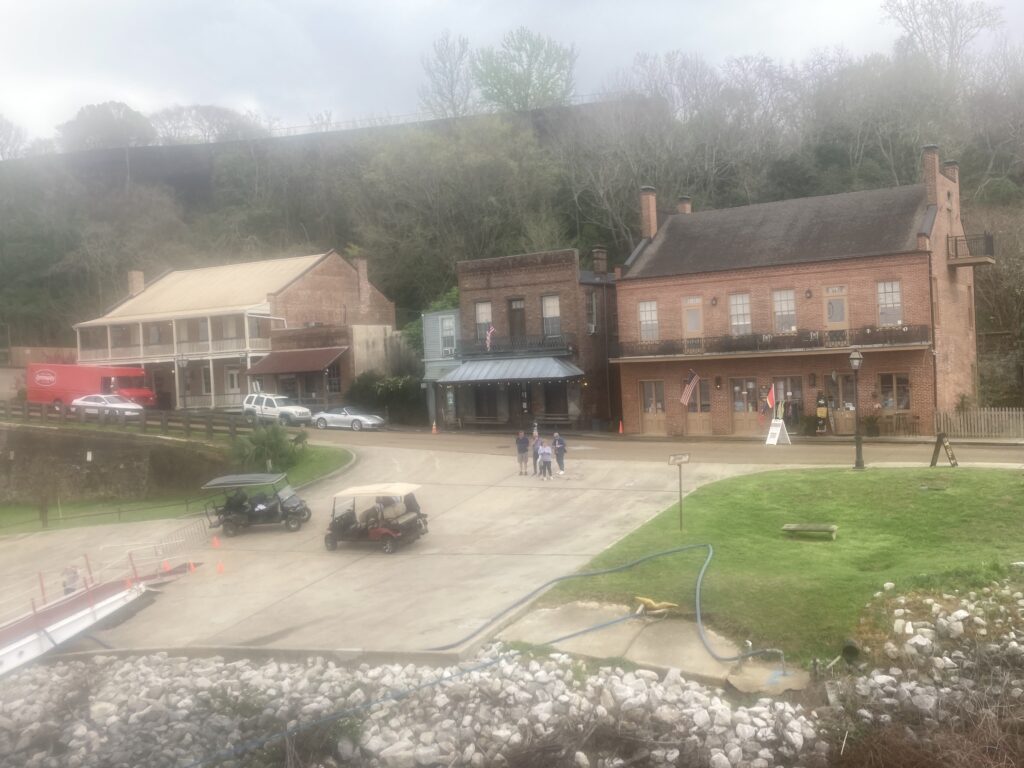
Natchez-Under-the-Hill, where we landed in Natchez, Mississippi, had a misty, Brigadoon-like quality when we arrived. Our golf carts were ready to help if needed. This was once a brawling river spot with bars and brothels, but today its few remaining buildings are nicely restored and more than respectable.. * Photo: Laurel Zimmermann
Up on the bluff we briefly toured Rosalie, another antebellum mansion. From its grounds I had a fine view of our boat, then we were off.
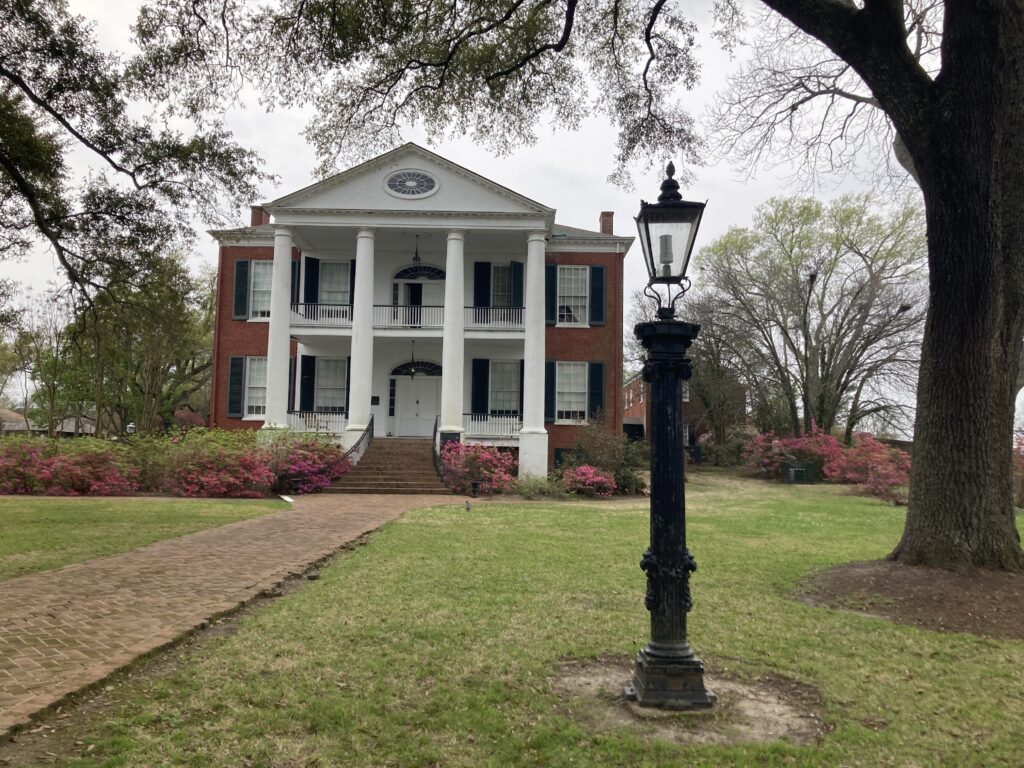
Rosalie Mansion, one of three antebellum homes available on our hop-on hop-off route, was a classic example of the genre. * Photo: Karl Zimmermann
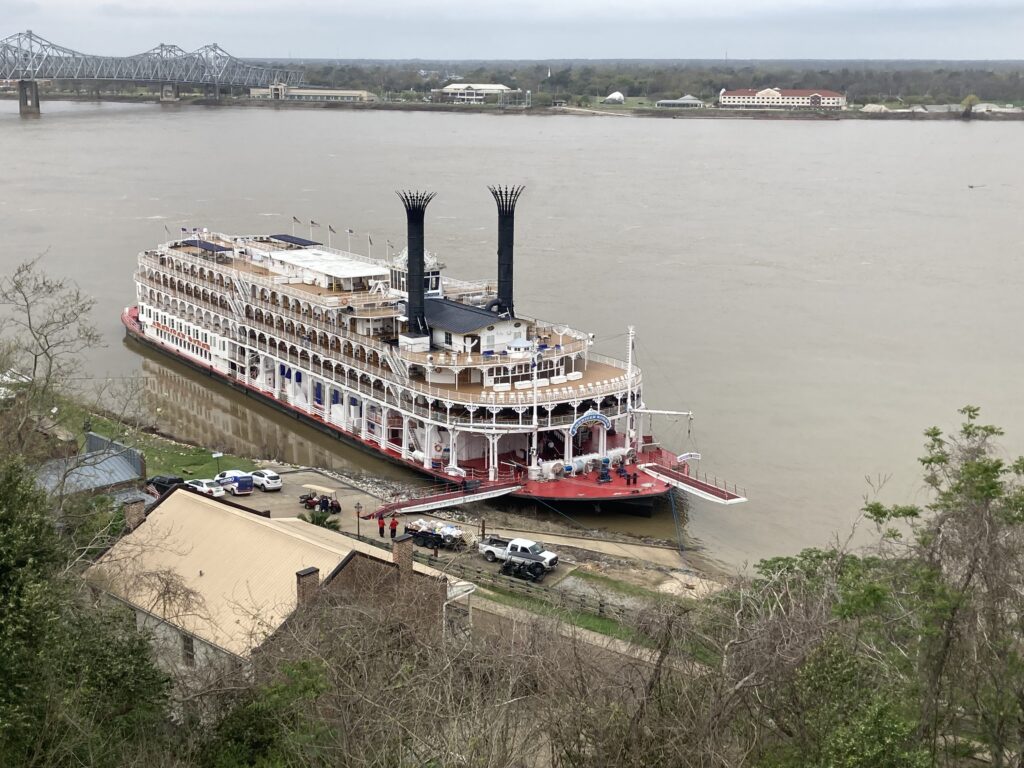
Rosalie Mansion’s grounds provided a splendid elevated view of the American Queen. * Photo: Karl Zimmermann
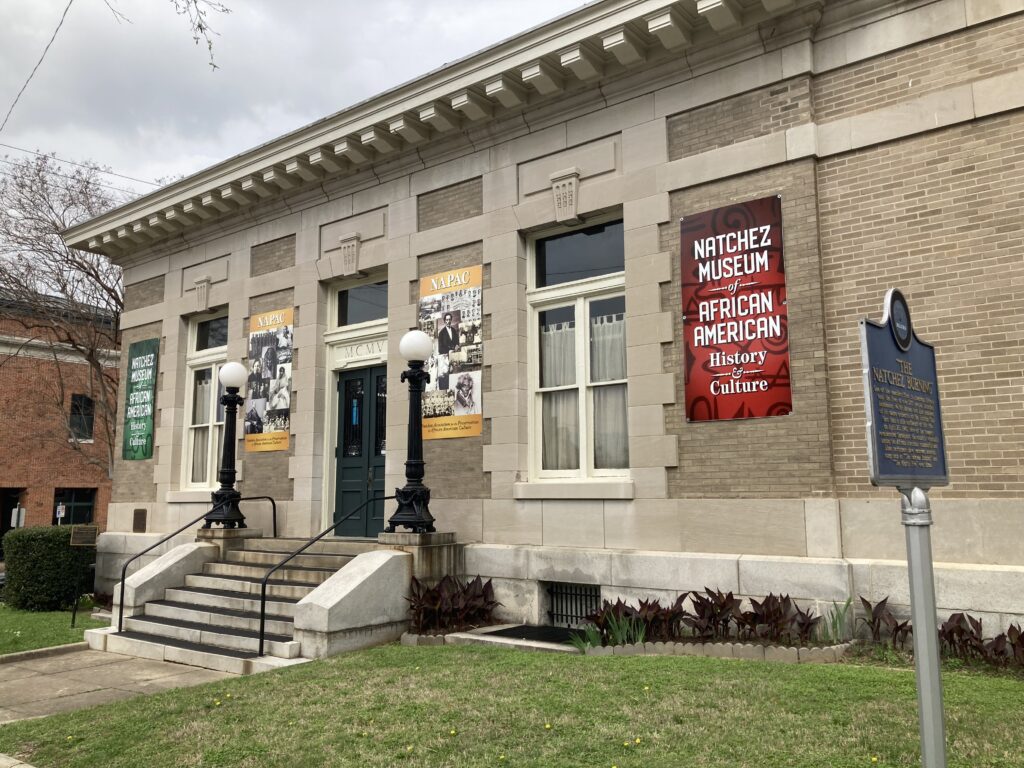
The Natchez Museum of African American History and Culture is a wide-ranging, jam-packed collection of displays and artifacts that fills multiple rooms in the old post office building. * Photo: Karl Zimmermann
In Vicksburg we hopped off first at the Vicksburg Civil War Museum, an excellent private collection that brought race relations into focus.
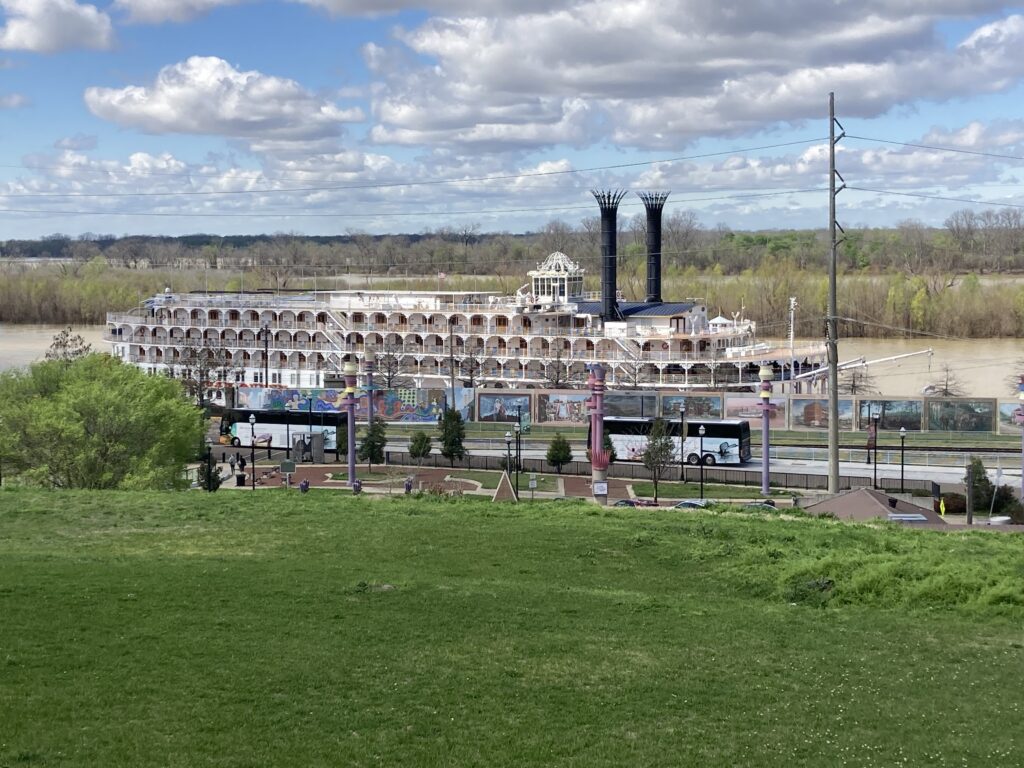
Another fine view of our boat came from Washington Street in Vicksburg, Mississippi, right across from the Vicksburg Civil War Museum and the Beidenharn Coca-Cola Museum, wildly different but both rewarding. Here you can see a pair of our spiffy buses and some of Robert Dafford’s wonderful murals. * Photo: Karl Zimmermann
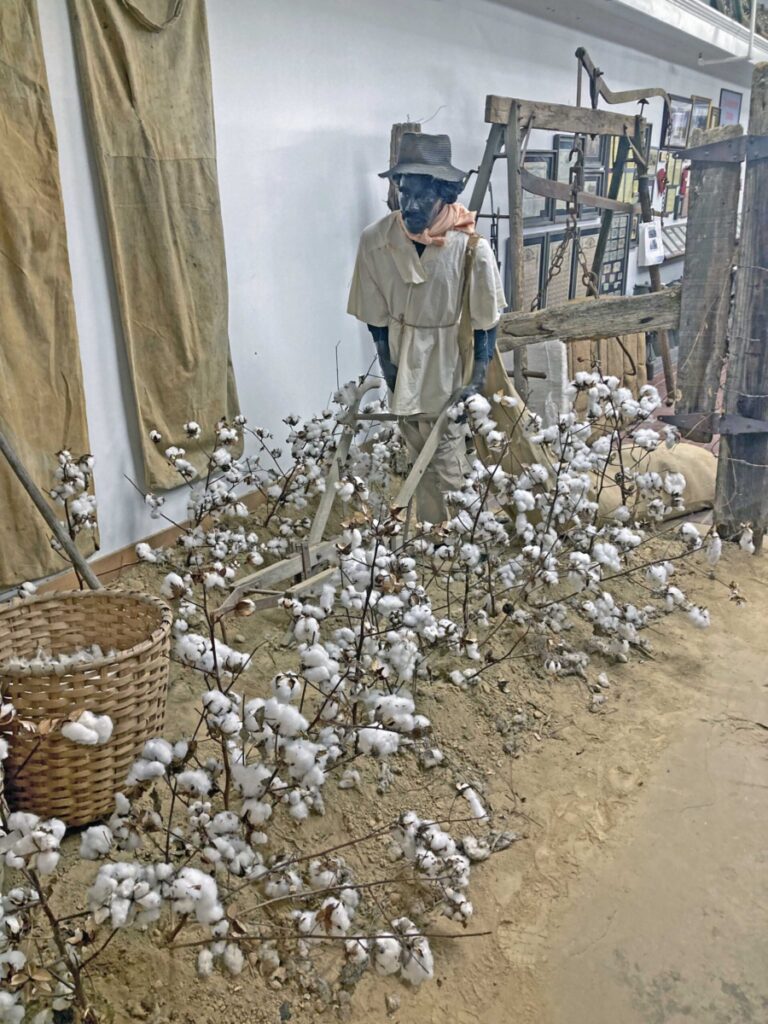
The Vicksburg Civil War Museum was an extraordinary private collection of artifacts and displays that chronicled not only the War but, just as importantly, the African American experience of that era, antebellum, wartime, and Reconstruction. The “Hop-on Hop-off Highlights” suggests a 20-30 minute visit but I could easily have spent half a day there. * Photo: Karl Zimmermann
Then we wandered one block from serious to frivolous and perused the memorabilia at the Biedenharn Coca-Cola museum, where that ubiquitous beverage is said to have been first bottled, in 1894.
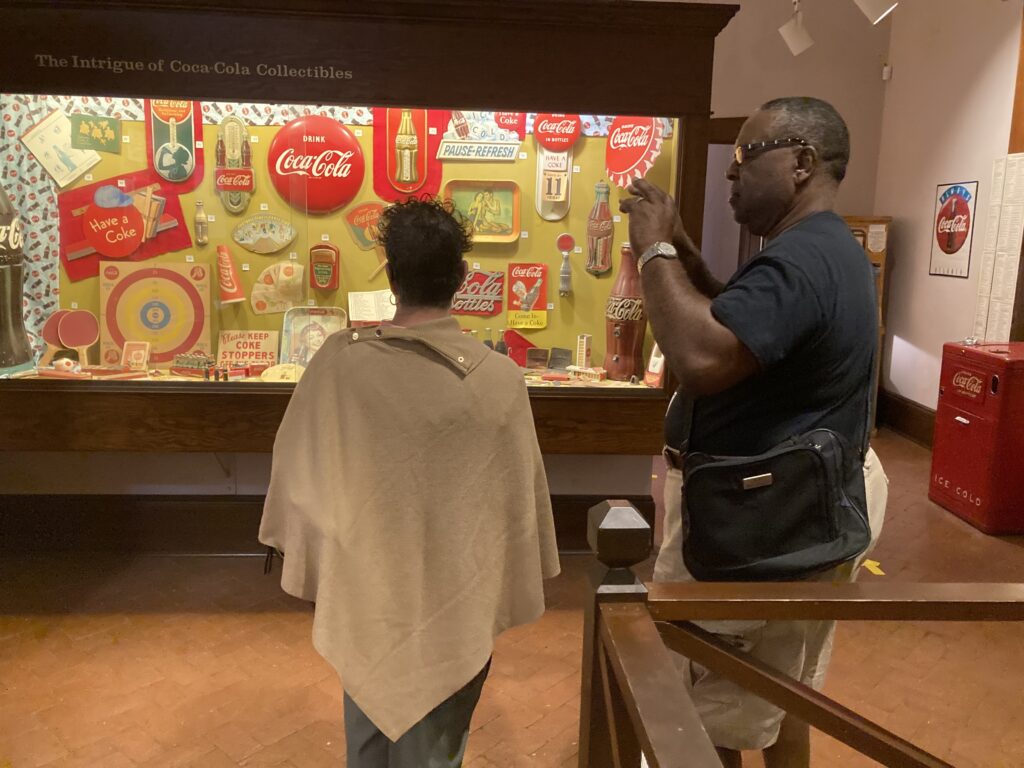
As a lover of collectables and ephemera, I naturally enjoyed the Biedenharn Museum, shared here with some of our fellow passengers. Everything Coke. * Photo: Karl Zimmermann
We couldn’t resist downing a Coke float before we went on to the Jesse Brent Lower Mississippi River Museum, where the highlight for me was to explore a retired tow boat similar to the ones we’d been watching on the river.
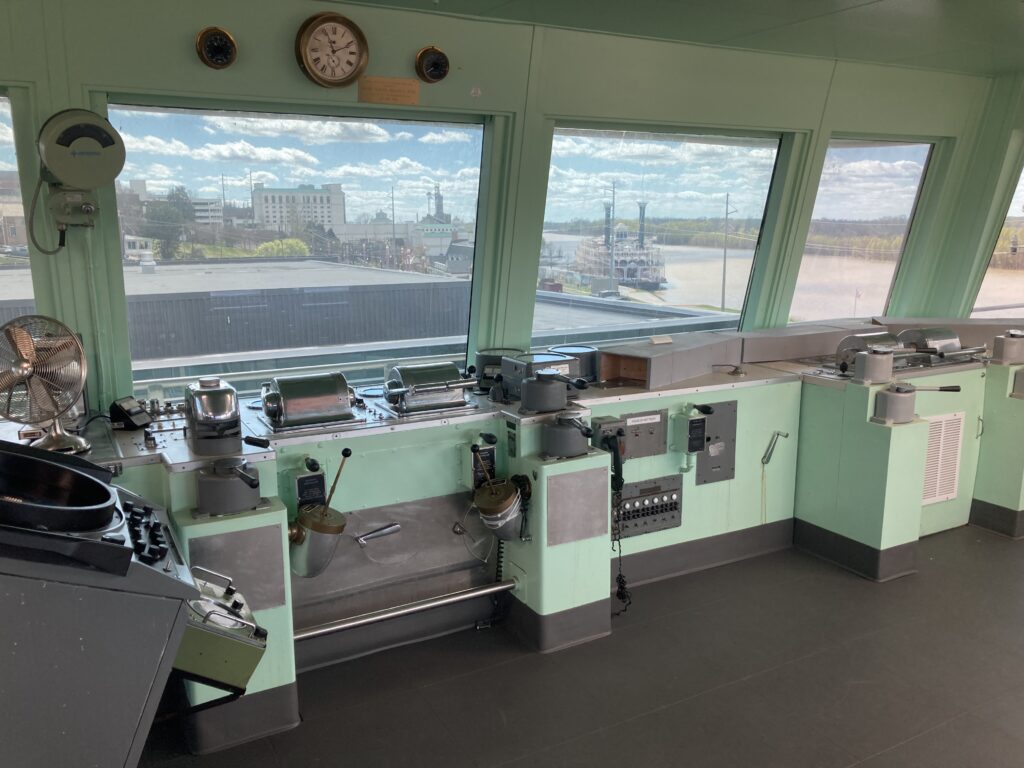
For me the unquestionable highlight of the Jesse Brent Lower Mississippi River Museum was the Mississippi IV, a working towboat that also served as the flagship for the Mississippi River Commission from the early 1960s until its retirement in 1993. This view from its pilot house shows its proximity to the American Queen. * Photo: Karl Zimmermann
Before re-boarding, I walked along the flood wall, admiring the 32 murals by artist Robert Dafford that depicted the city’s history.
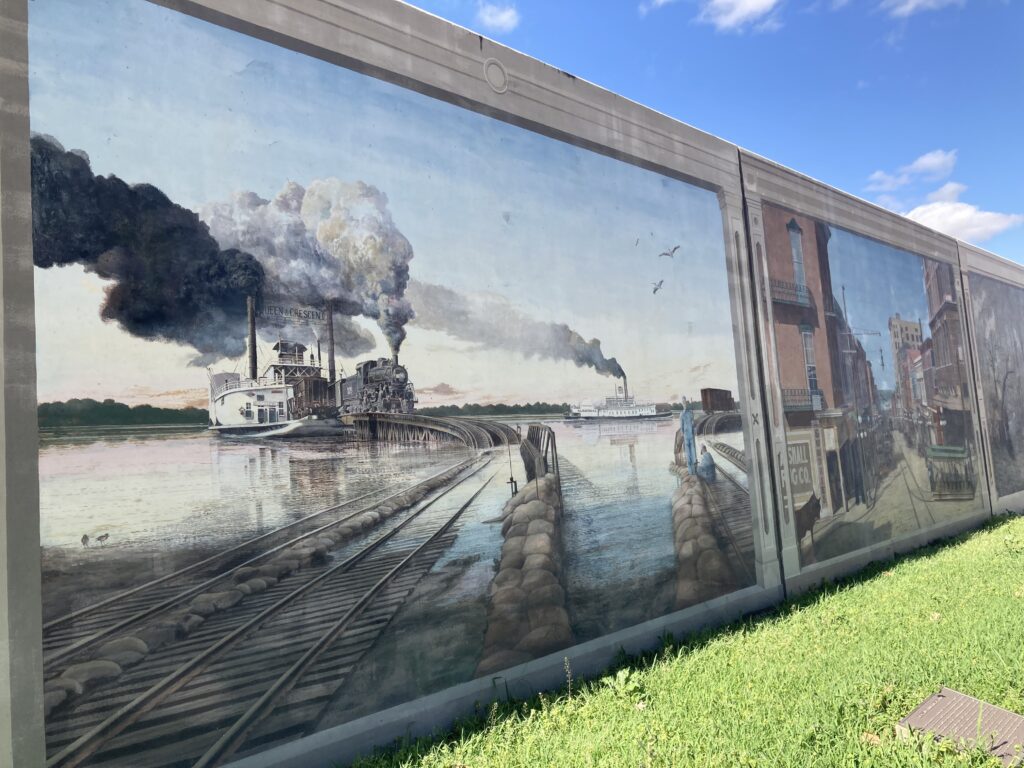
Each of Robert Dafford’s seawall murals deserved attention, and this one combined two of my passions, steamboats and steam locomotives. Another favorite featured local bluesman Willie Dixon and his quote: “The blues are the roots, the rest are the fruits.” * Photo: Karl Zimmermann
Steamboating Aboard American Queen
For the next two days we were on the river, no port until Tunica in the late afternoon of the second. This suited us just fine, as we never tired of watching for tows, or hoping for a low bridge ahead that would require the stacks to be lowered, always an event that drew spectators.

The numerous tows we saw throughout our voyage provided a sense of riverine life and the commercial significance of the Mississippi. We knew from Lee that tows bound downriver like this one will let the current steer them around bends, a technique called “flanking.” * Photo: Karl Zimmermann
In addition to deck time, we headed to the J. M. White Dining Room for the jazz brunch held on the portless day, with the Steamboat Syncopators playing in the adjacent Captain’s Bar. We tried some a la carte items, Crab Benedict and Shrimp Creole with creamy grits, but were happier with the buffet, especially the charcuterie plate. Shrimp cocktail, and smoked salmon.
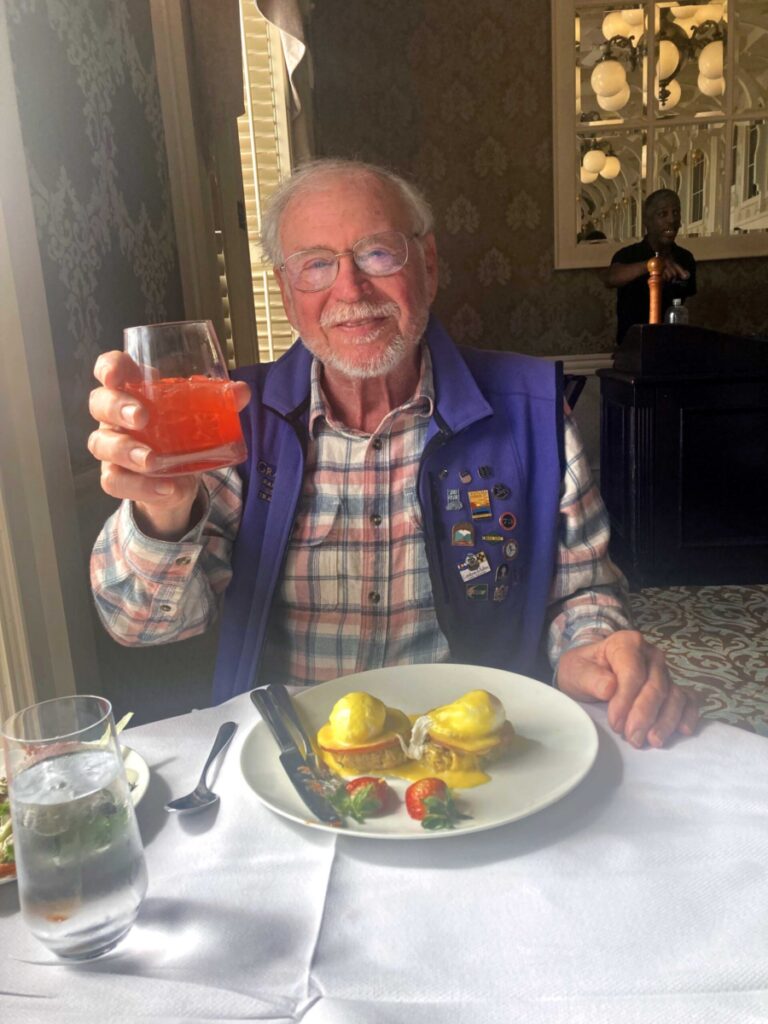
The jazz brunch in the J. M. White Dining Room on one of the “steamboating” days was great fun, though my Crab Benedict actually looked better than it tasted. Can’t remember the name of this specialty cocktail. No matter. I wouldn’t order it again. * Photo: Laurel Zimmermann
But the Syncopators, the brassy quintet that backed all the shows, were even better than the food.
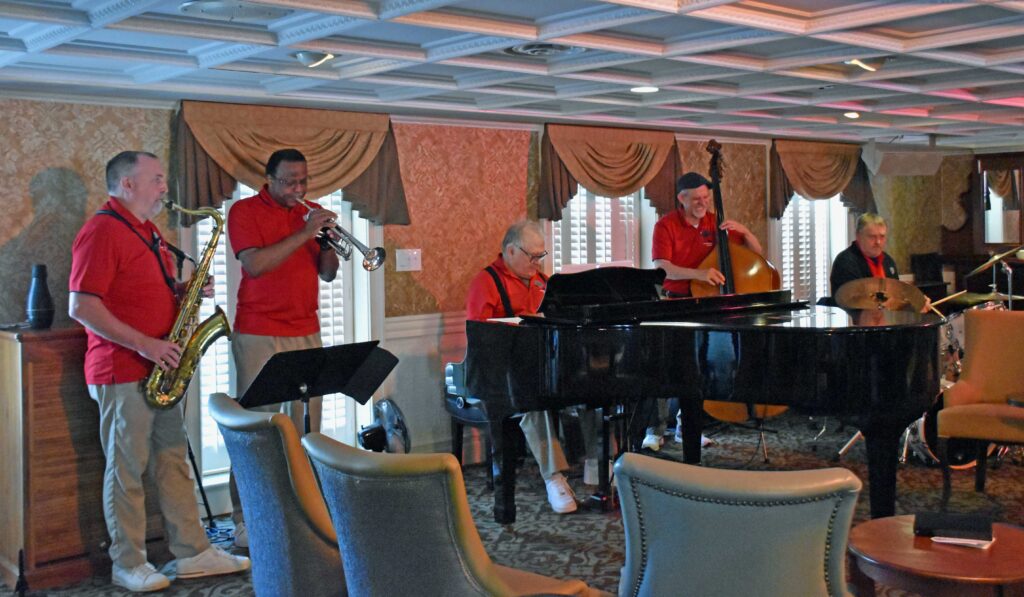
The Steamboat Syncopators, playing here in the Captain’s Bar adjacent to the dining room during the jazz brunch, were a very talented group and a highlight of the voyage for us. * Photo: Karl Zimmermann
Lead by pianist Gary Peterson, whose jazz chops included not just New Orleans style but also bebop, this group swung behind an engaging quartet of singers and dancers, and we caught every show: music of the South, of the 70s, and, our favorite: “Curtain Up, Songs of Broadway.”
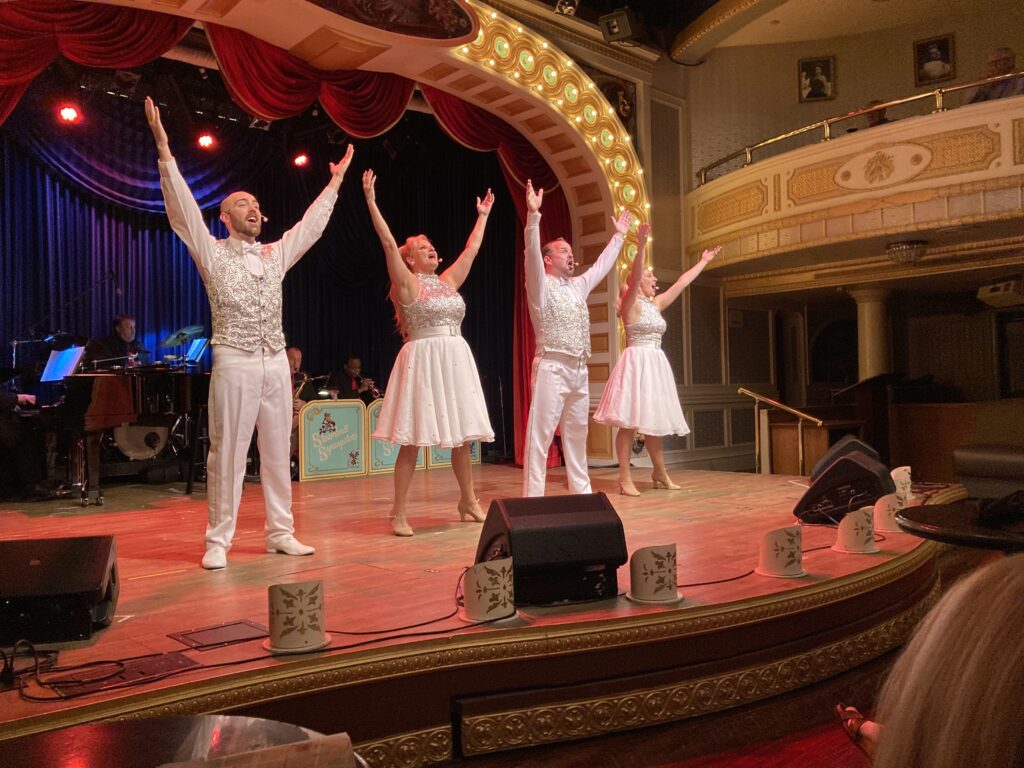
Here at the finale of the Broadway show, our favorite, are the cast, left to right: Brandon Janssen, Lainie Gulliksen, Alex Bernhardt, and Maggie McMurran. Alex also served as cruise director with Maggie as his assistant. * Photo: Karl Zimmermann
All the music heard aboard the American Queen was made aboard the American Queen, nothing taped, a claim few vessels in the cruise industry can make.
RELATED: Heidi writes about American Queen’s entertainment options for Travel Weekly.
Then the final day: packing, strolling the decks, one last “River Chat” in the Grand Saloon with Lee, a last dinner in the J. M. White Dining Room annex.
Before that, we passed up a brief look at the museum at Tunica (the already late arrival of 5pm had been pushed back even further by high water) and watched a last sunset from one of the balconies off the Engine Room Bar, where we could also see the crew improvising a repair to the “monkey rudder” behind the paddle wheel, one of two rudders (among the many things we learned from Lee).
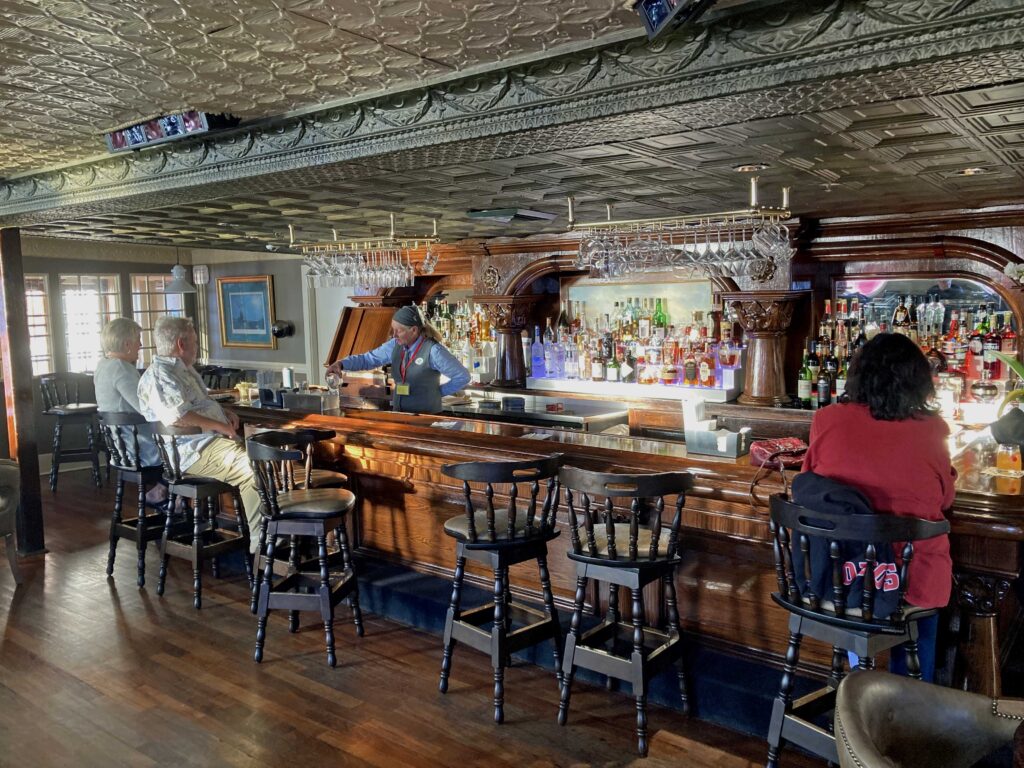
In the Engine Room Bar the bartender pours a martini. On the wall opposite are portholes that look out on the paddlewheel. Not the least of the room’s charms are the stairs from there down to the engine room itself. * Photo: Karl Zimmermann
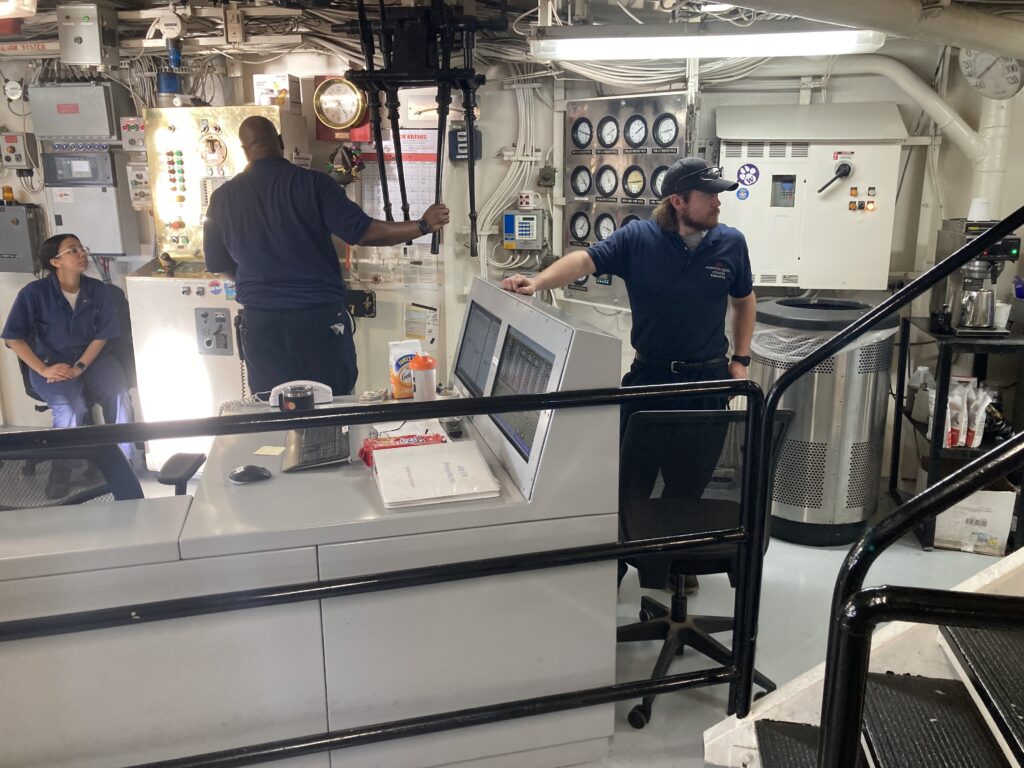
Redolent of steam and grease, the engine room was one of my favorite places and — in a longstanding Delta Queen Steamboat and now American Queen Steamboat tradition — it’s completely welcoming to passengers. In this view the engineer has his hand on the throttle as we begin to ease out into the Yazoo River, just off the Mississippi, where we’re staged for Vicksburg. In the engine room is a box of souvenirs, small red-tinged wooden squares cut from broken “bucket-boards” from a snag-damaged paddle wheel. One is now on my bureau in New Jersey, reminding me of a fine voyage. * Photo: Karl Zimmermann
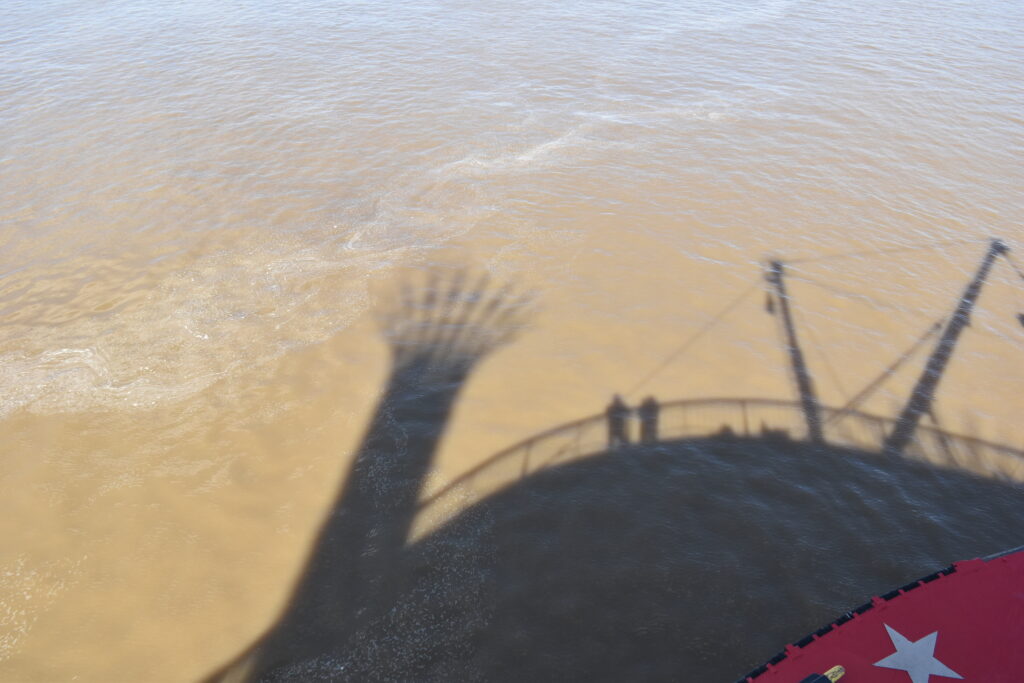
The highfalutin stacks of the American Queen are arguably its most emblematic appurtenance. Here Laurel and I are framed by the port stack and the masts of the port landing stage as we gaze at the muddy Mississippi. * Photo: Karl Zimmermann
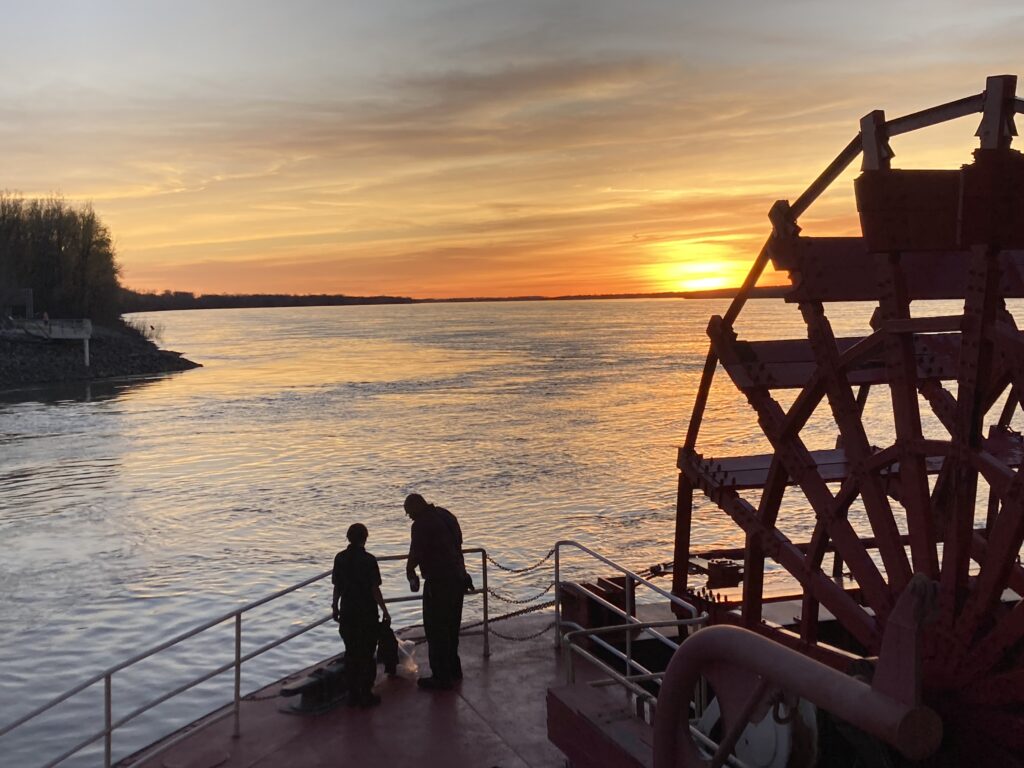
Eschewing a late visit to Tunica, we spent the final evening on the porch off the Engine Room Bar, watching the sun fall as the engine room crew jerry-rigged a broken connection to the “monkey rudder” so we could make our final lap to Memphis that night. (The monkey rudder is the second of two on the boat, behind the paddle wheel. Thanks again, Lee, for putting us in the know.) * Photo: Karl Zimmermann
The next morning we were in Memphis, where roughly 28 years earlier we had begun our first voyage aboard the American Queen, the one which ended with us “choking a stump.”
Interested in This Cruise?
The 7-night American Queen cruises between New Orleans and Memphis start at $3,729 per person and include open-bar and daily hop-on hop-off excursions.
We’re already looking forward to our next voyage on the American Queen, perhaps on the Ohio or Upper Mississippi, very different but equally wonderful experiences.
Don’t miss a post about small-ship cruising, subscribe to QuirkyCruise.com for monthly updates & special offers!
© This article is protected by copyright, no part may be reproduced by any process without written permission from the author. All Rights Reserved. QuirkyCruise.com.

